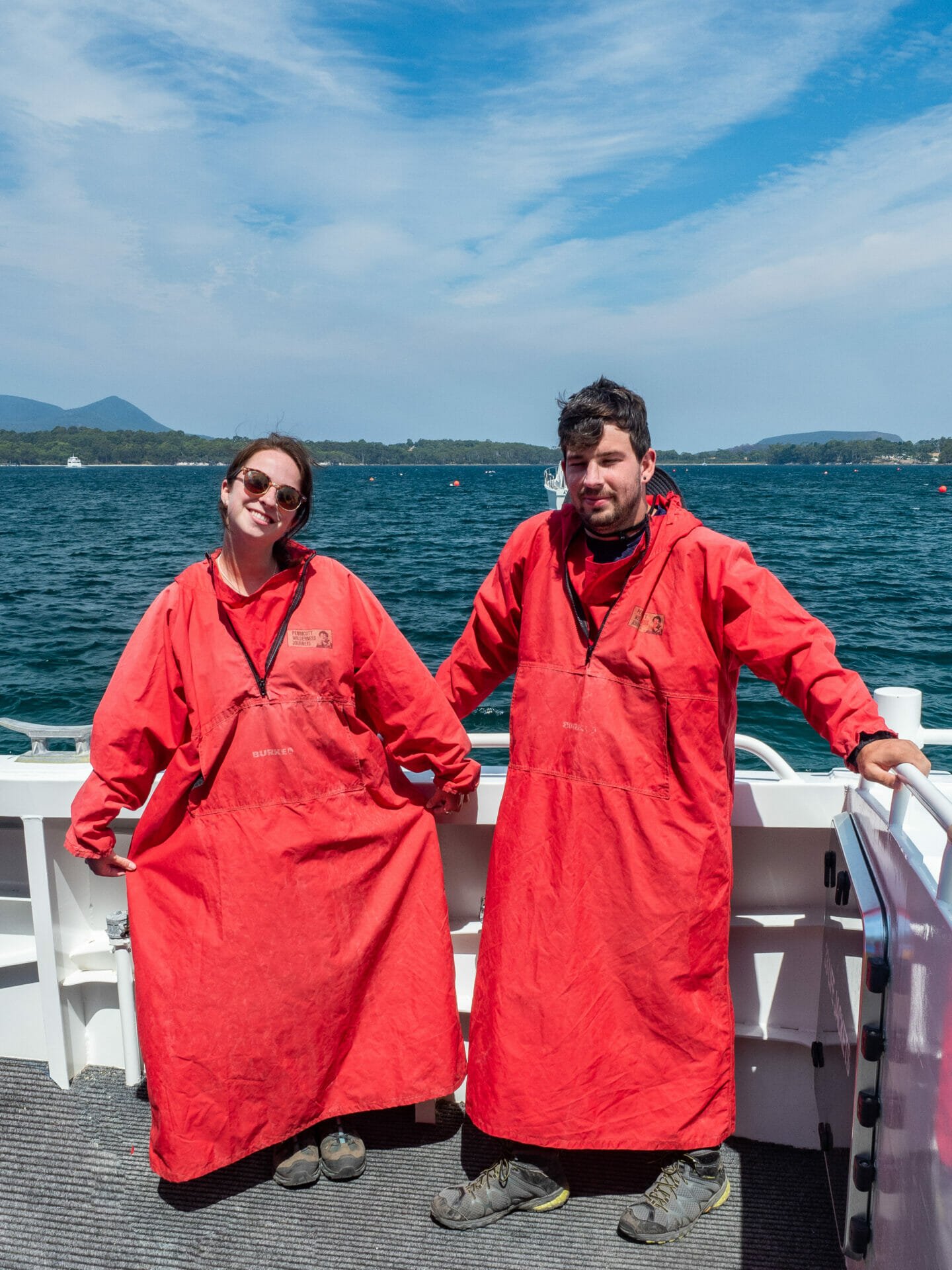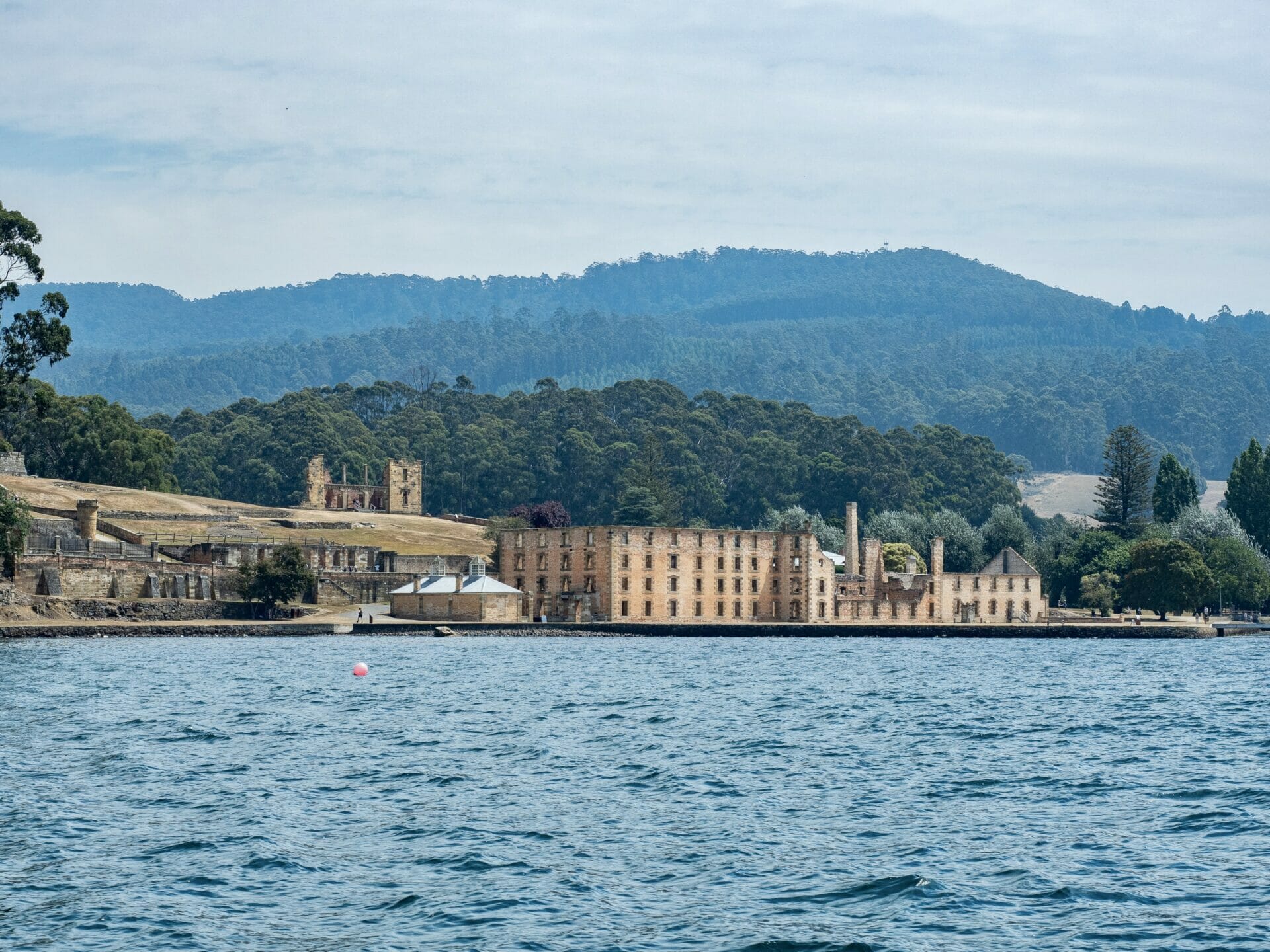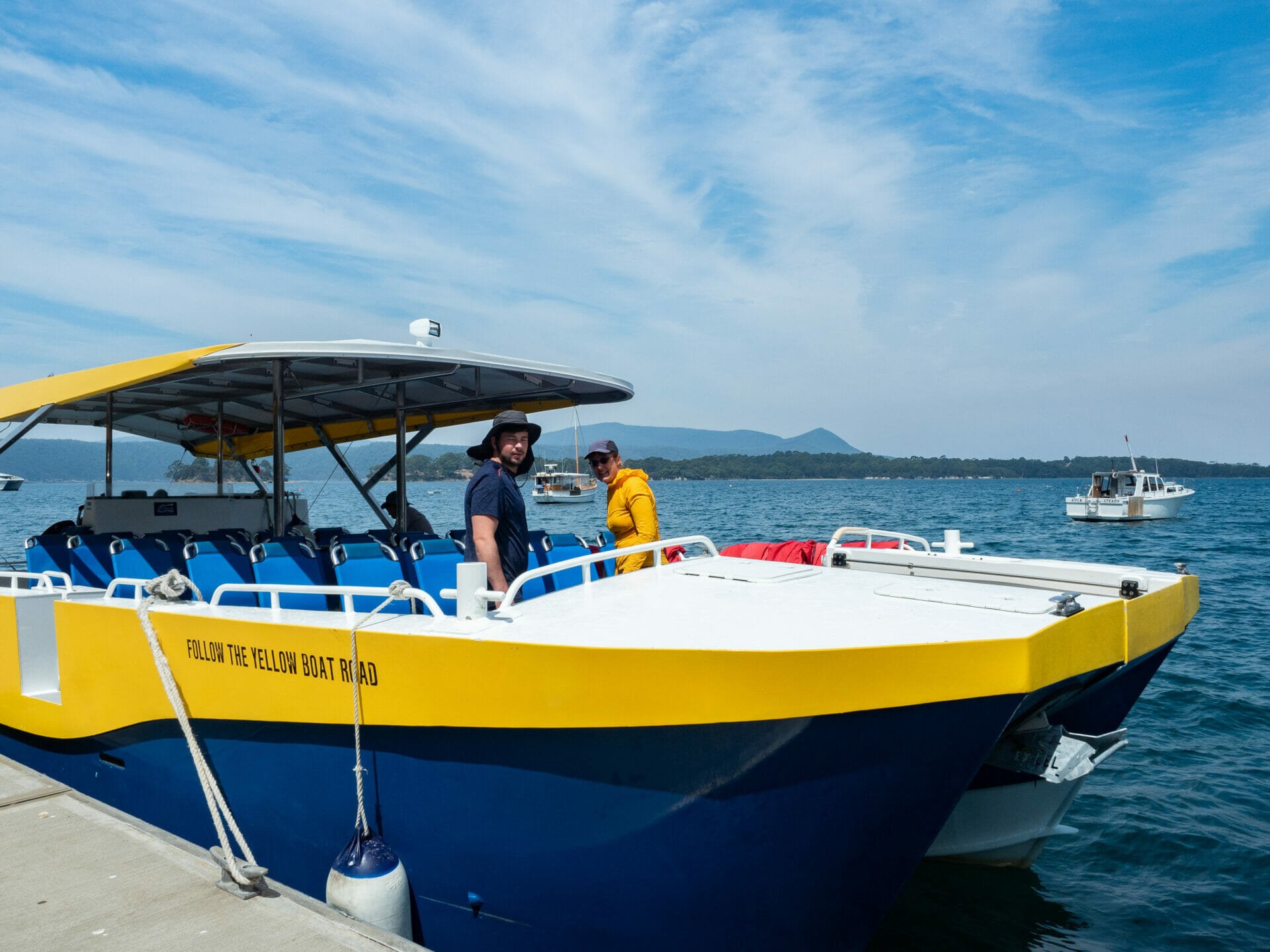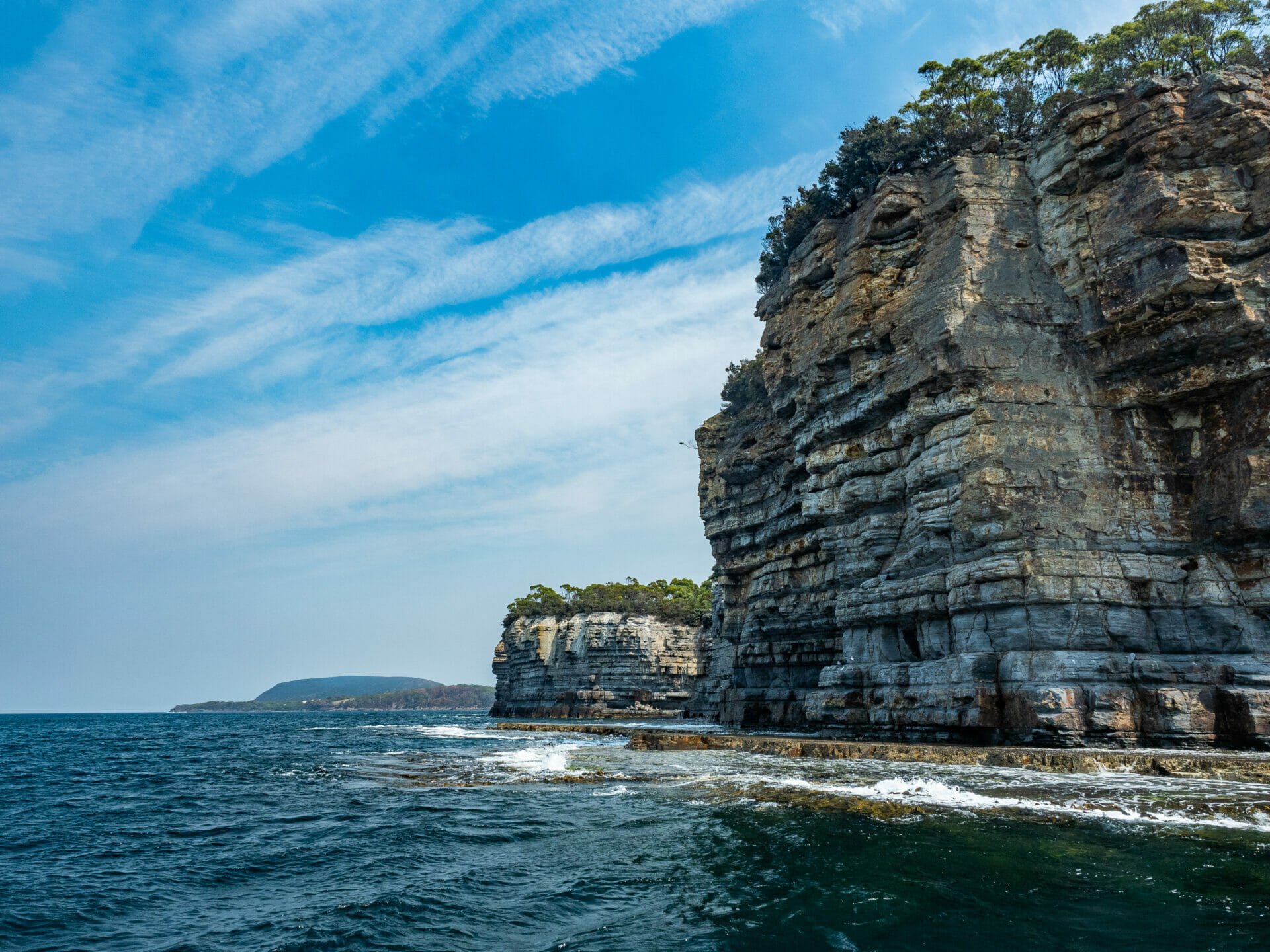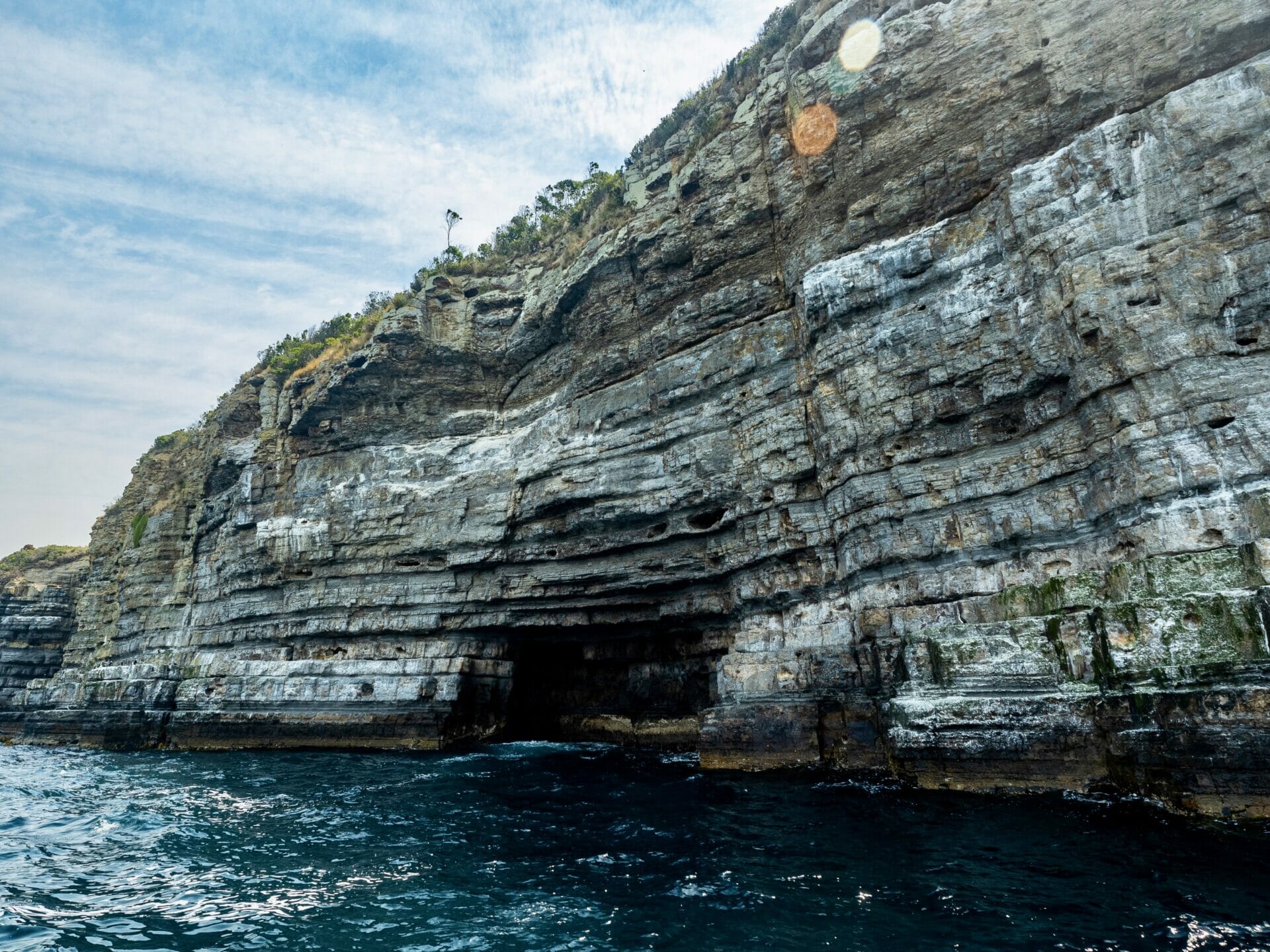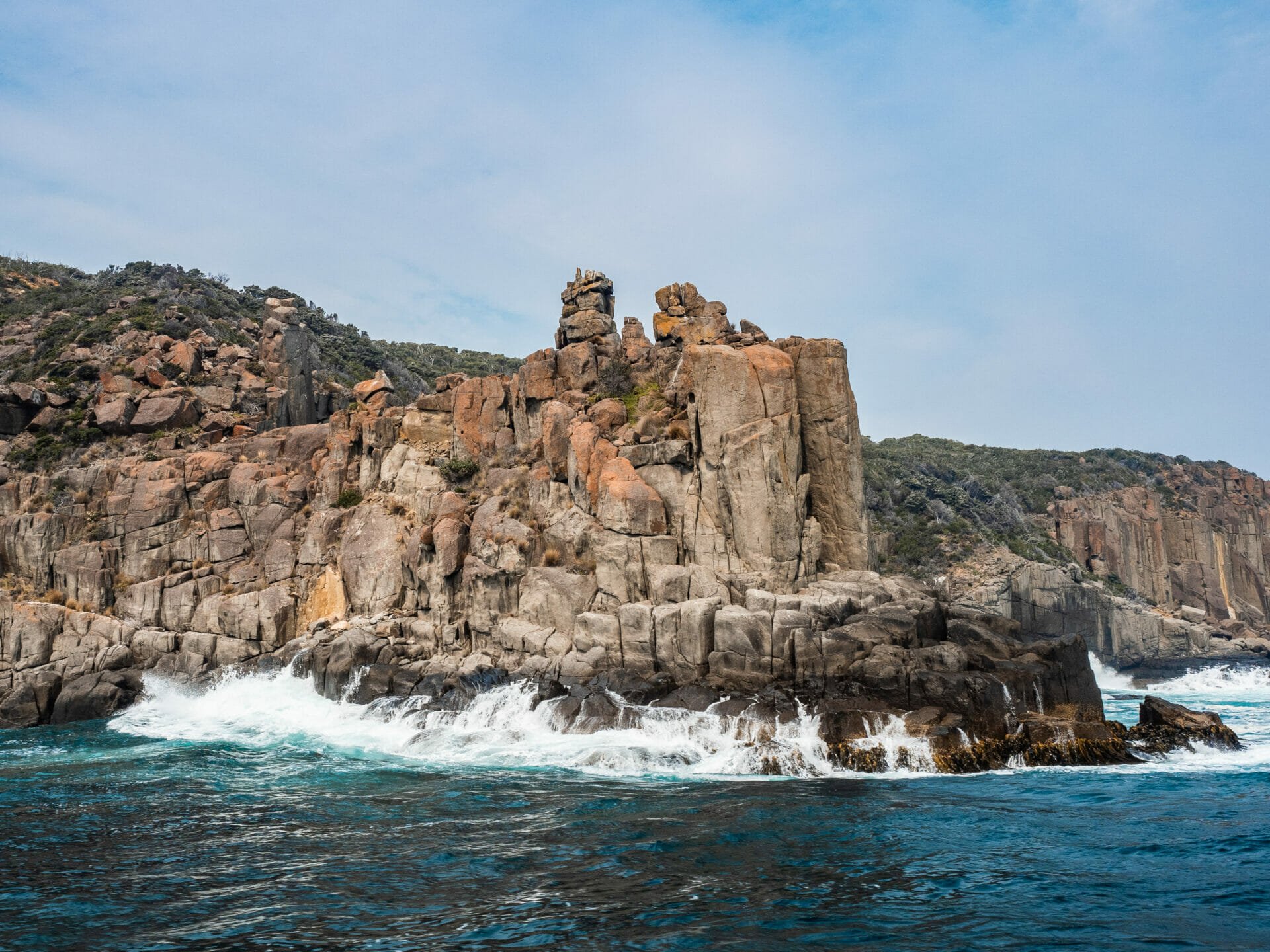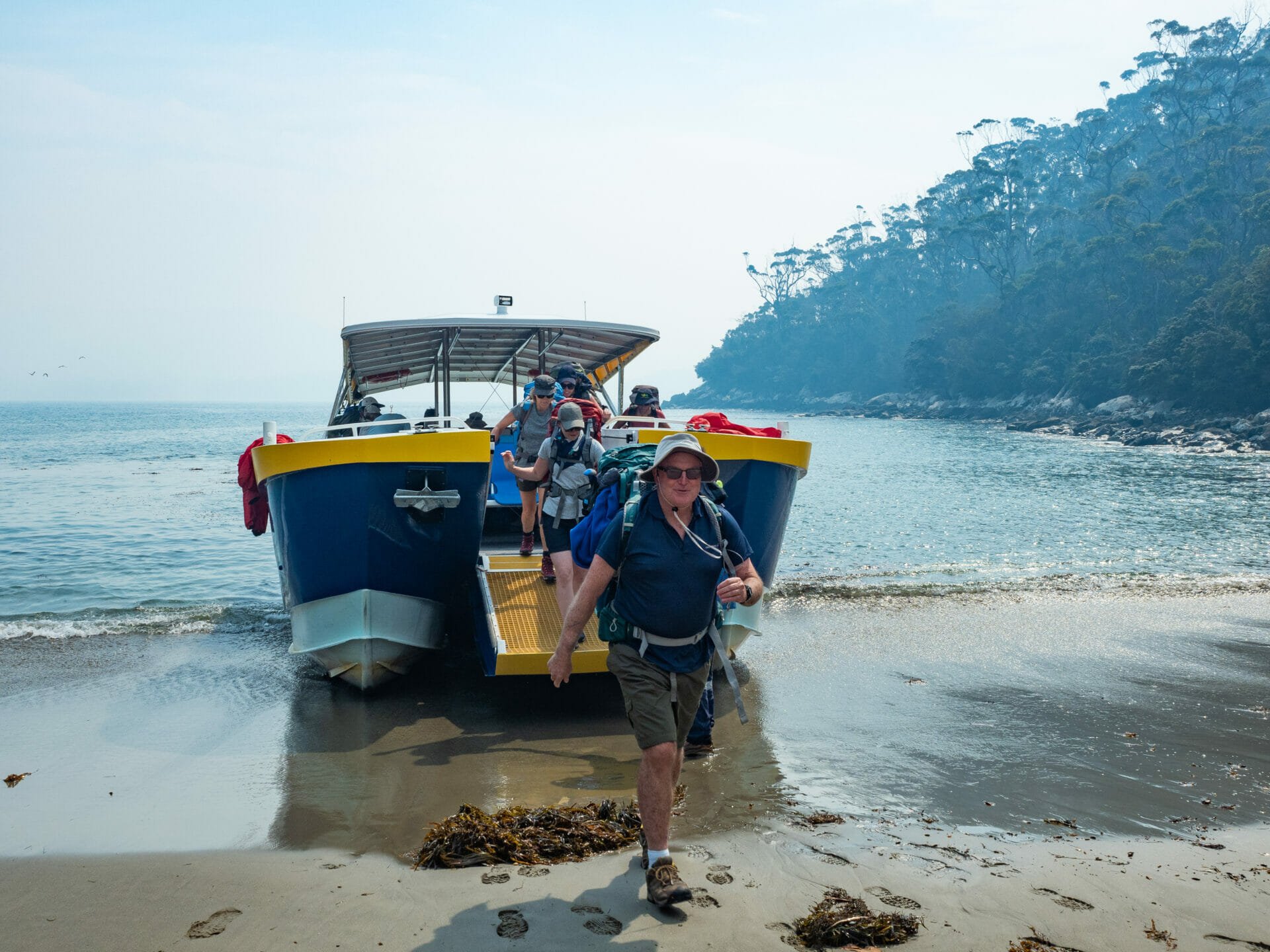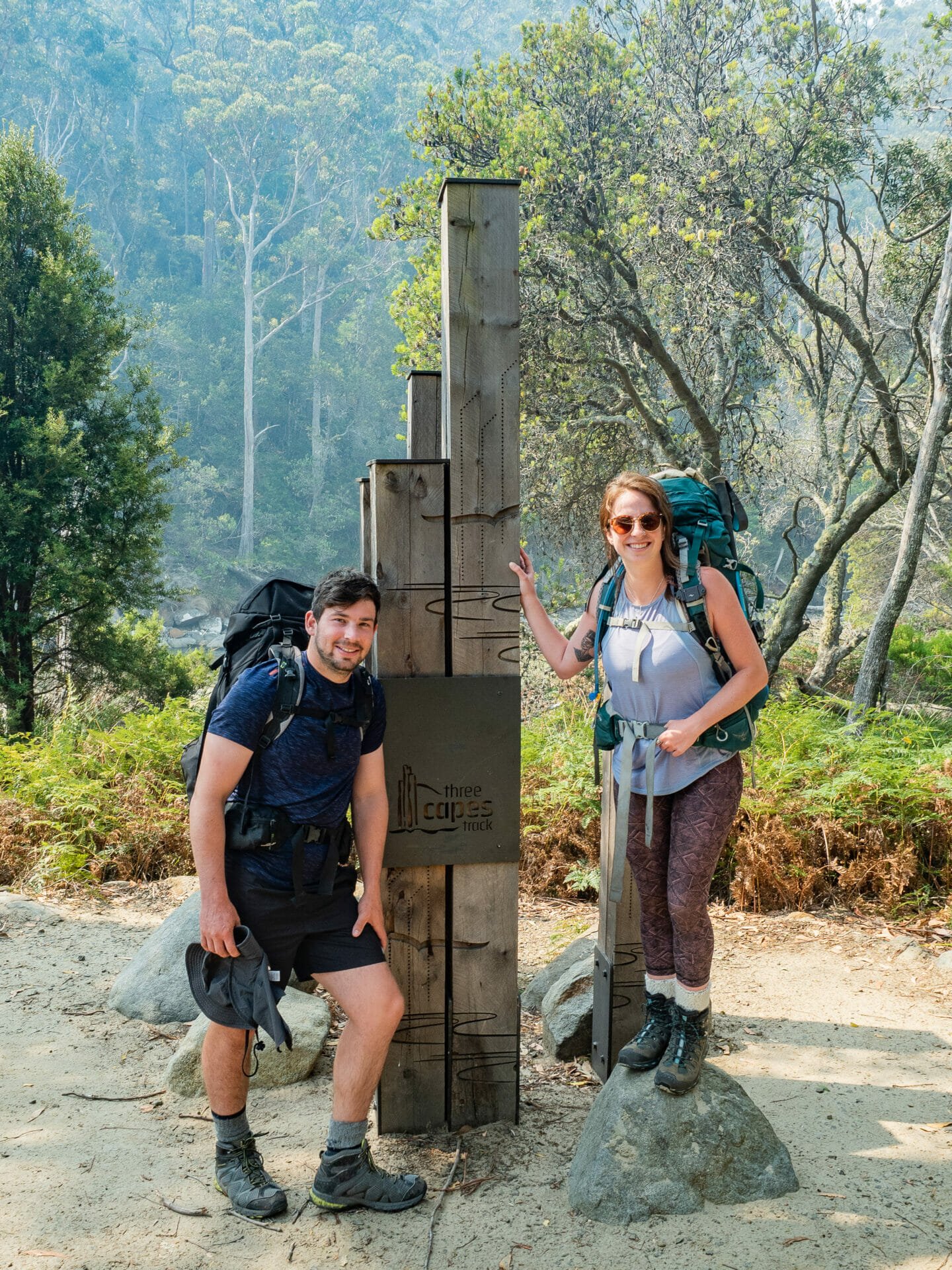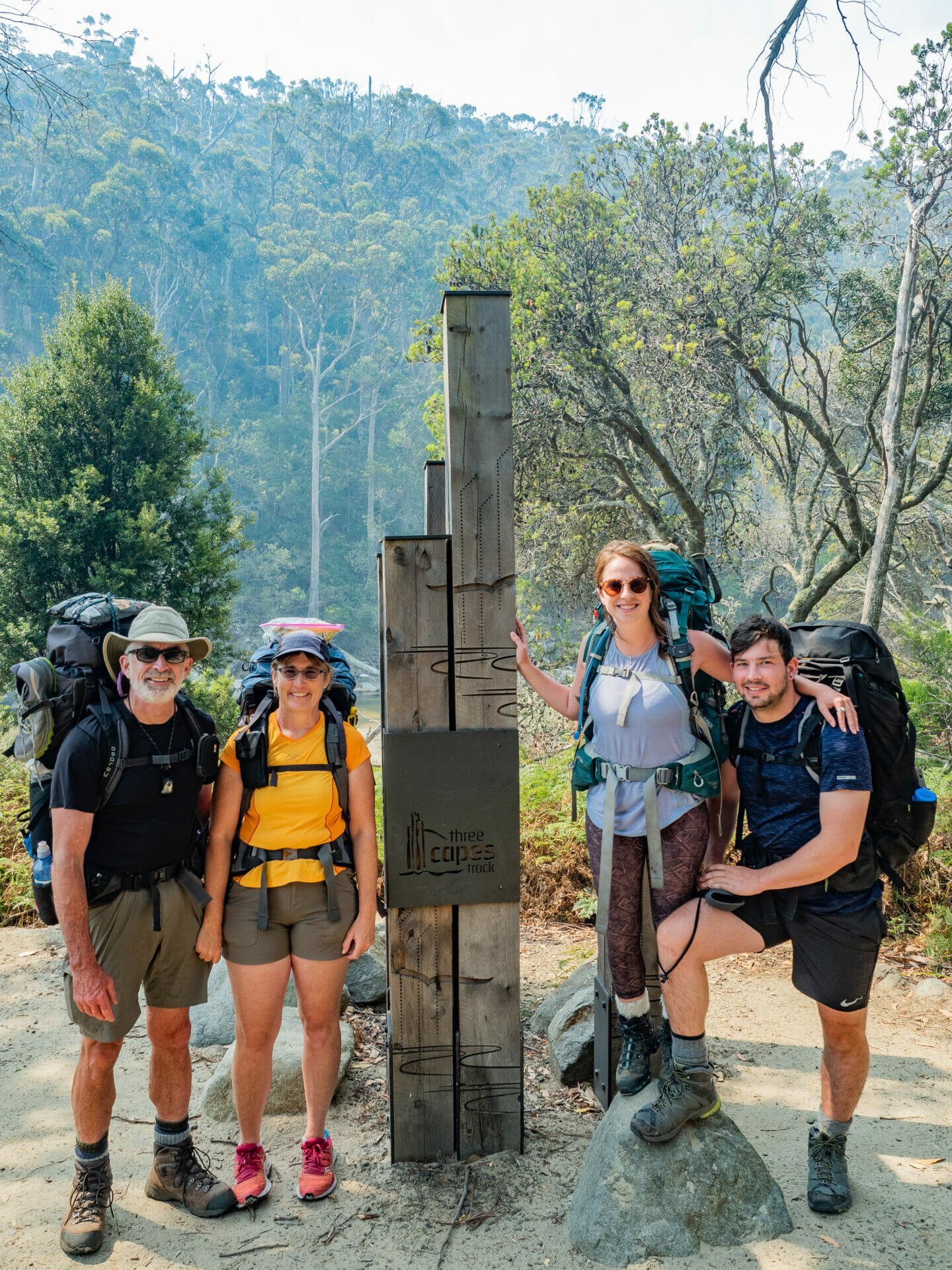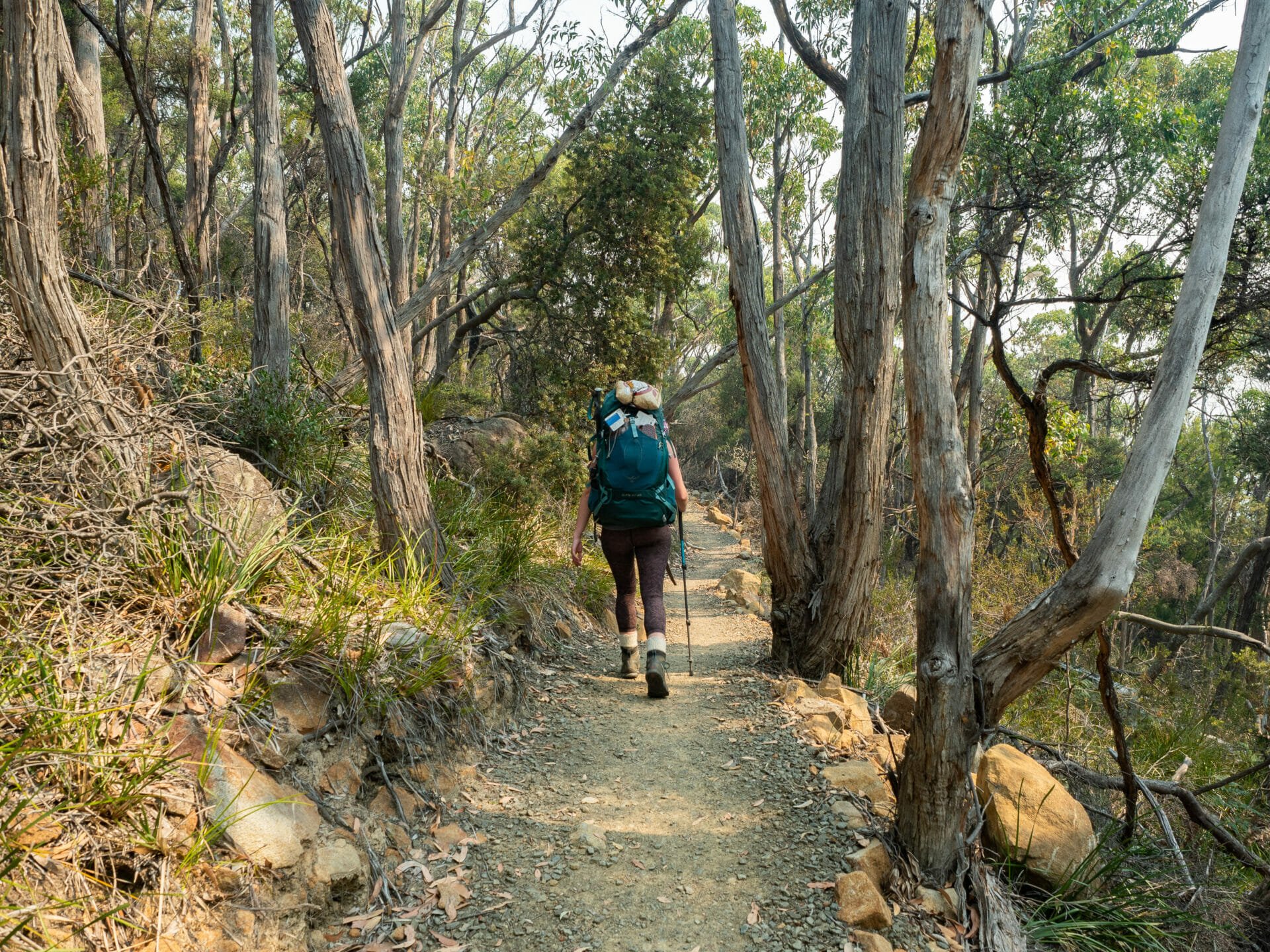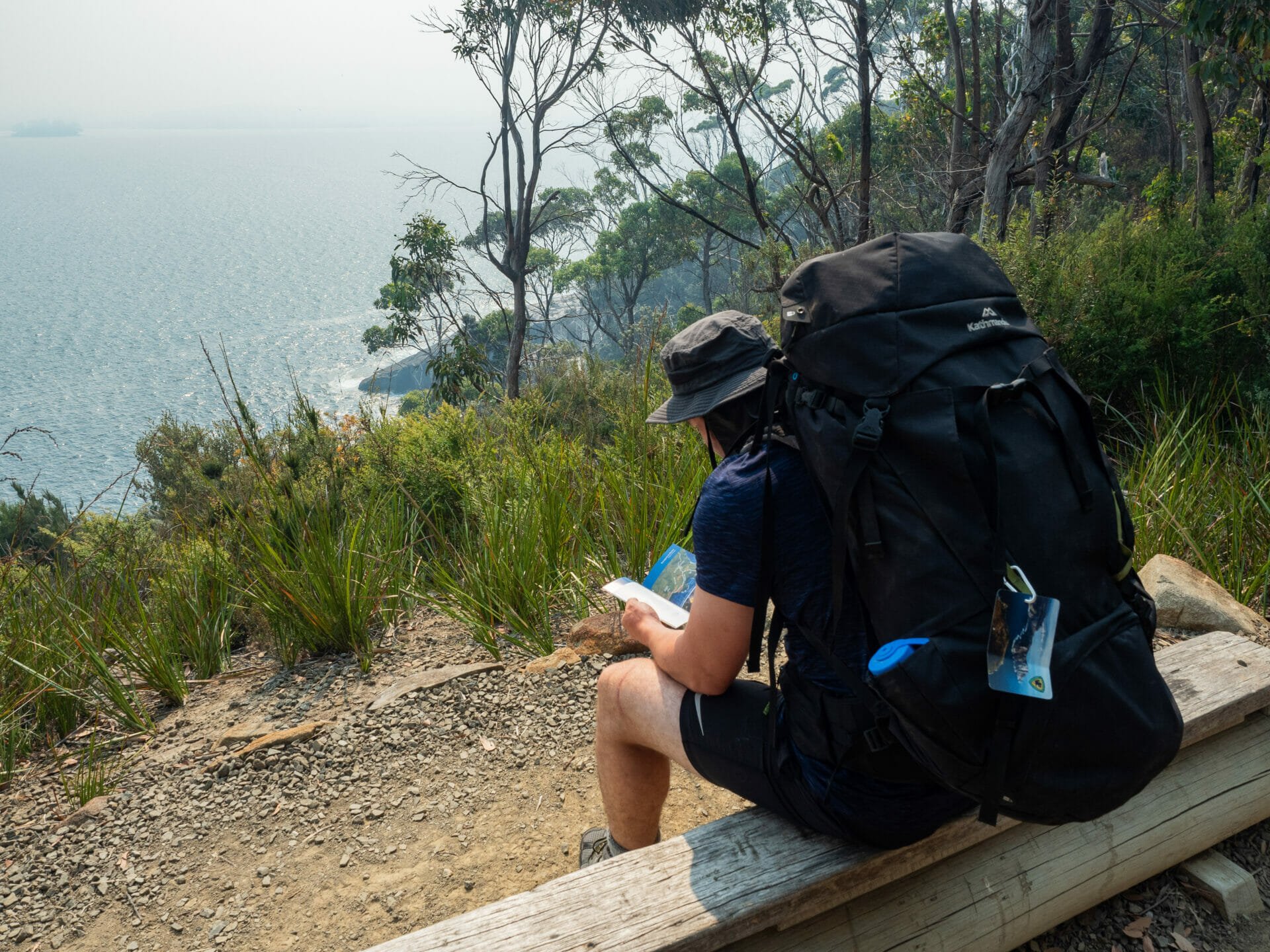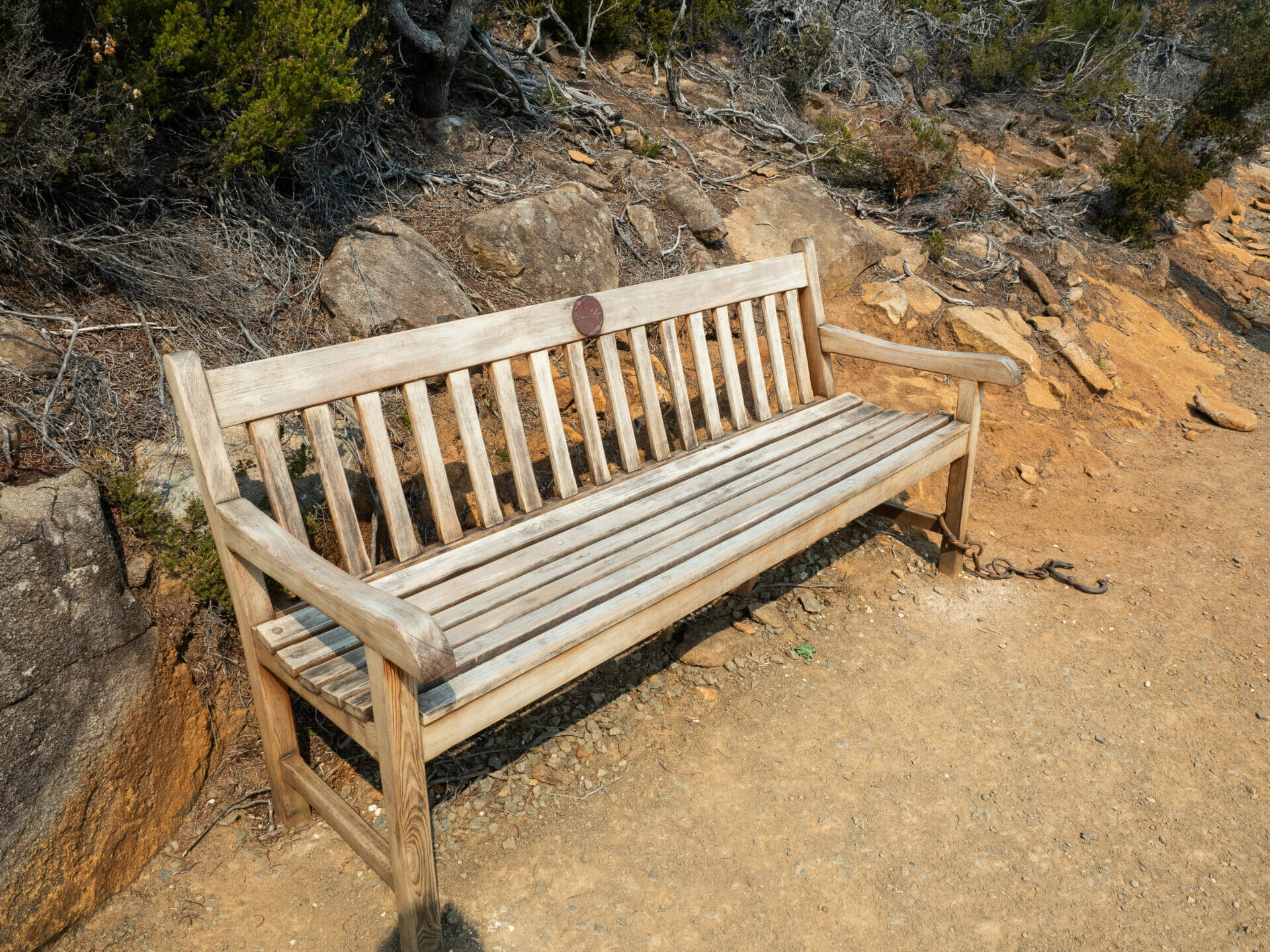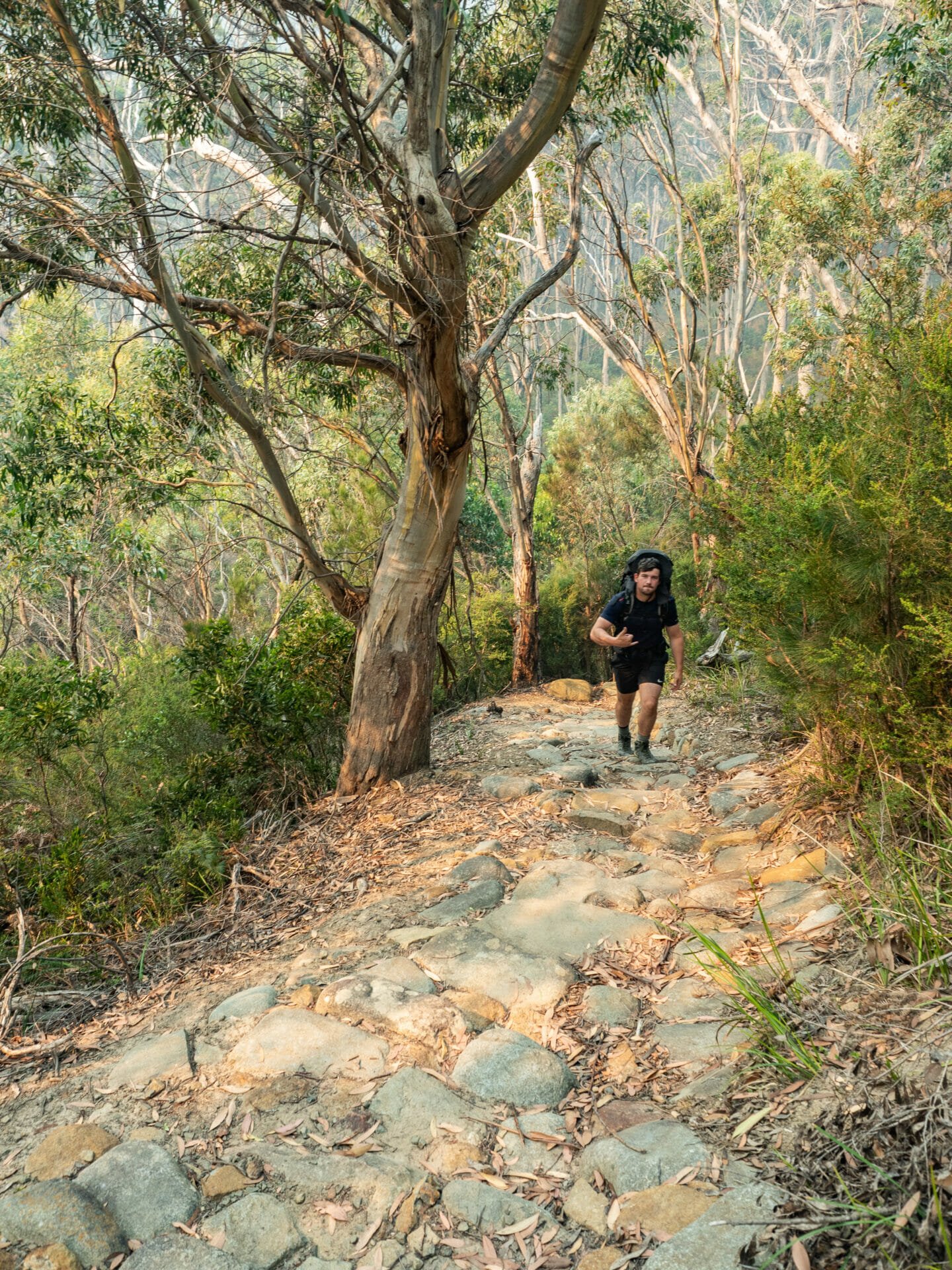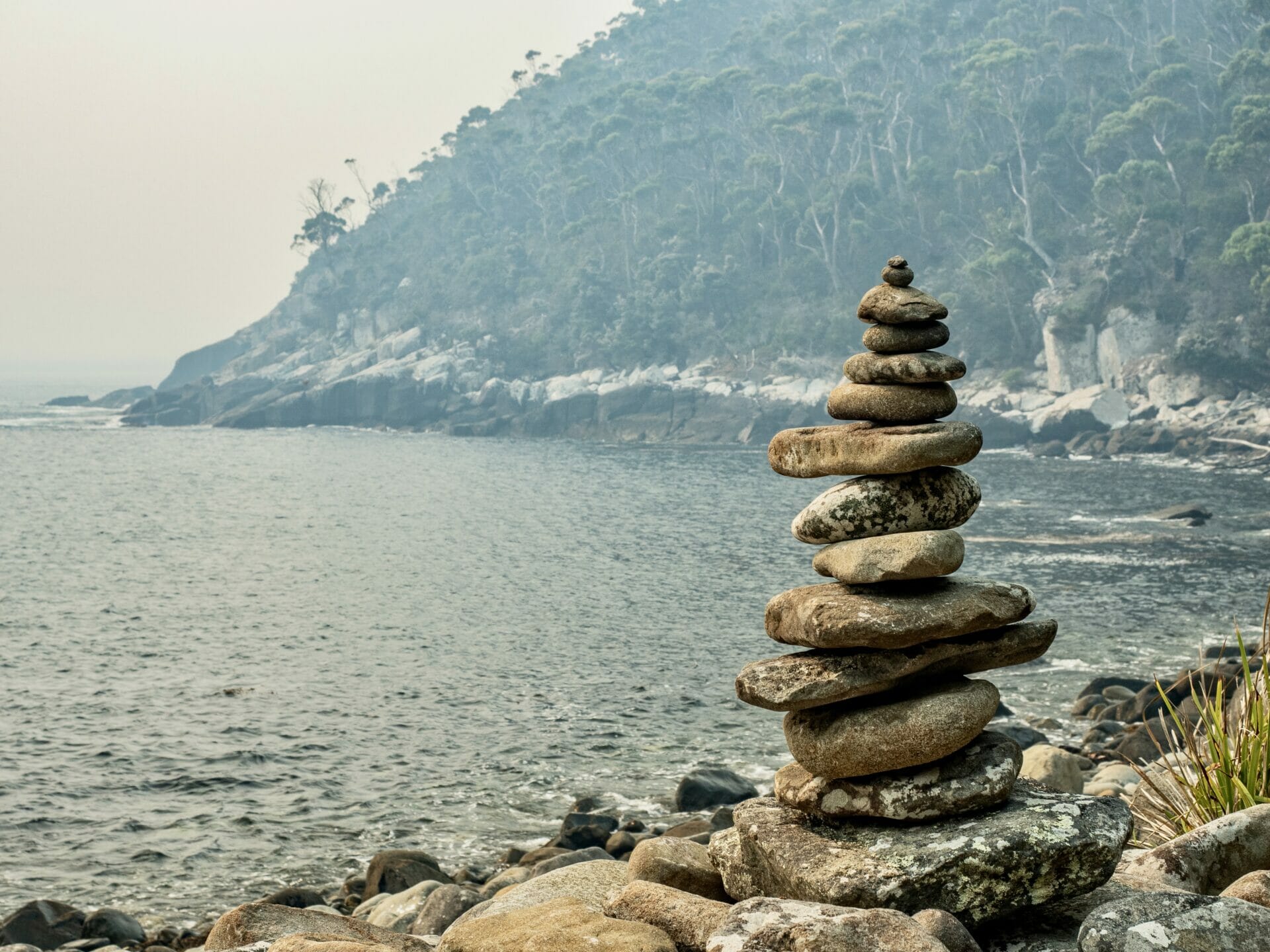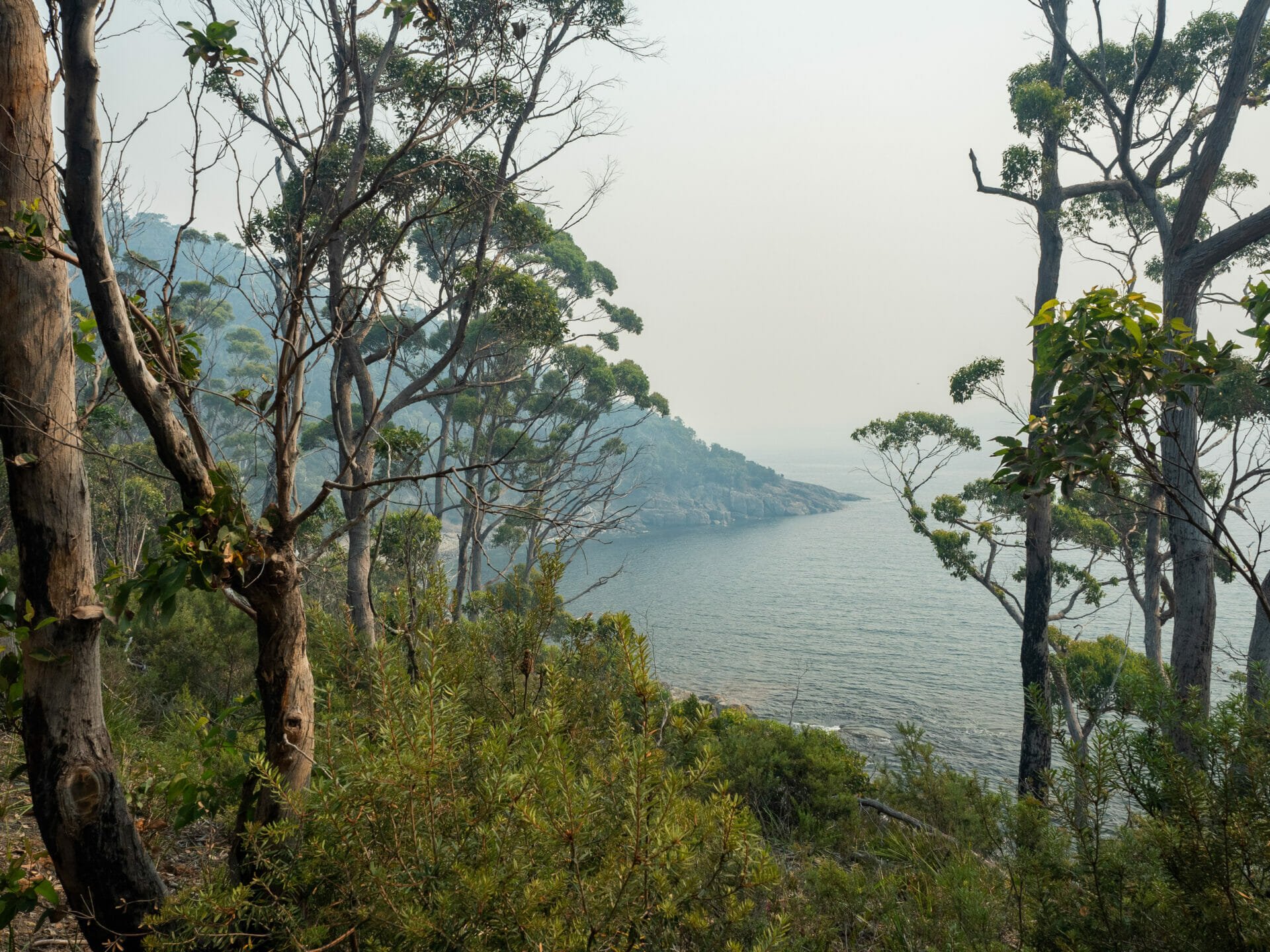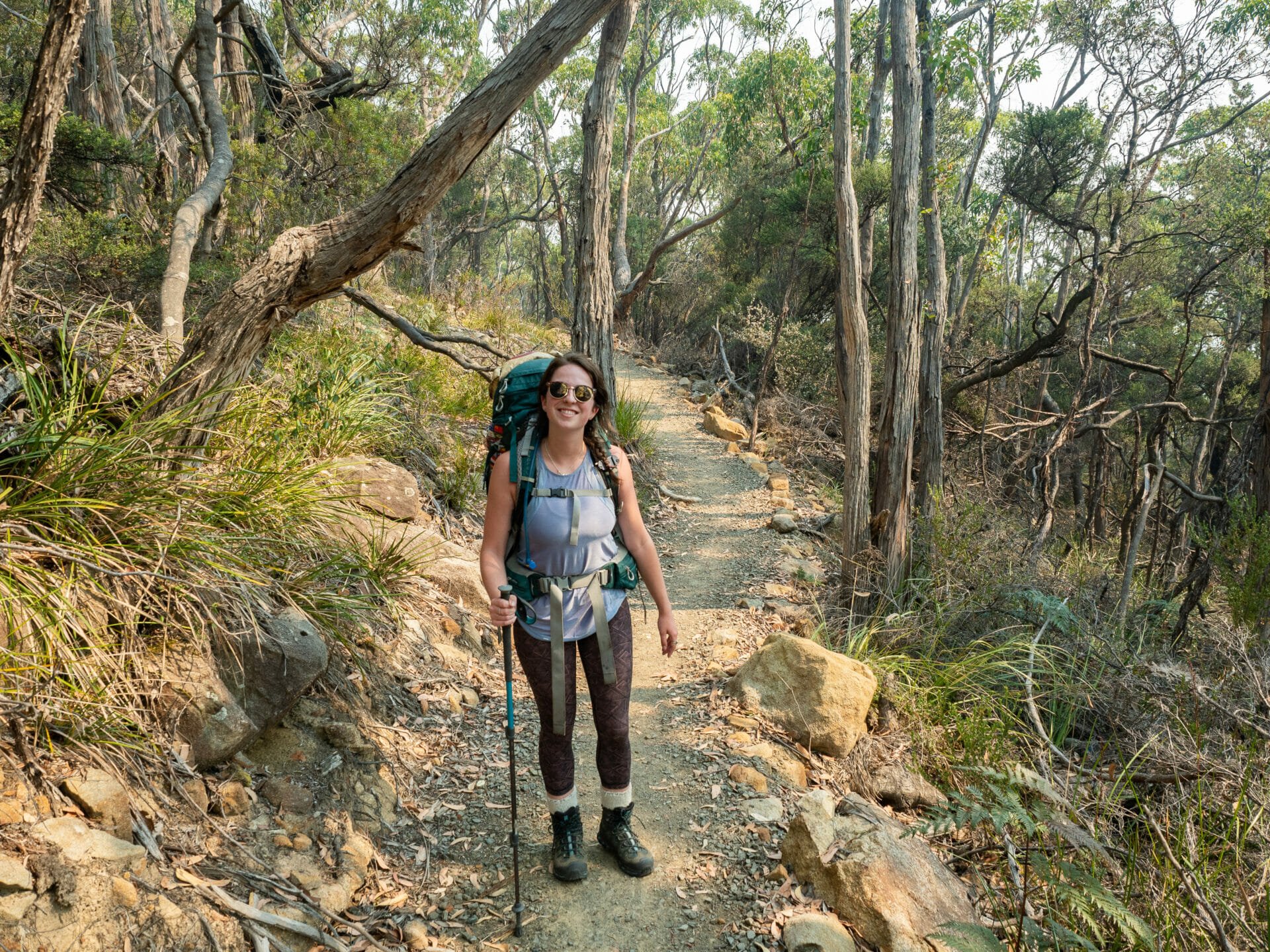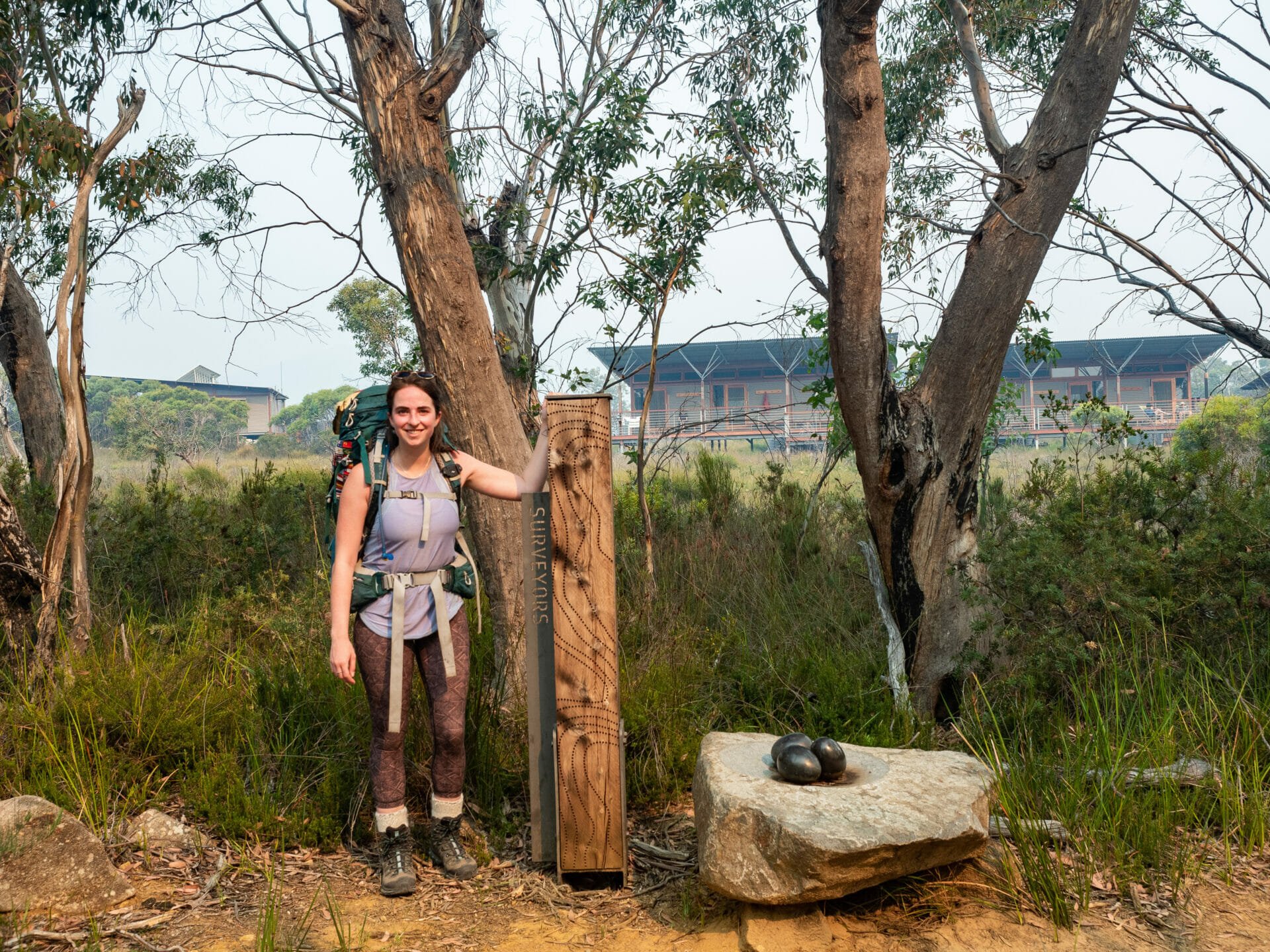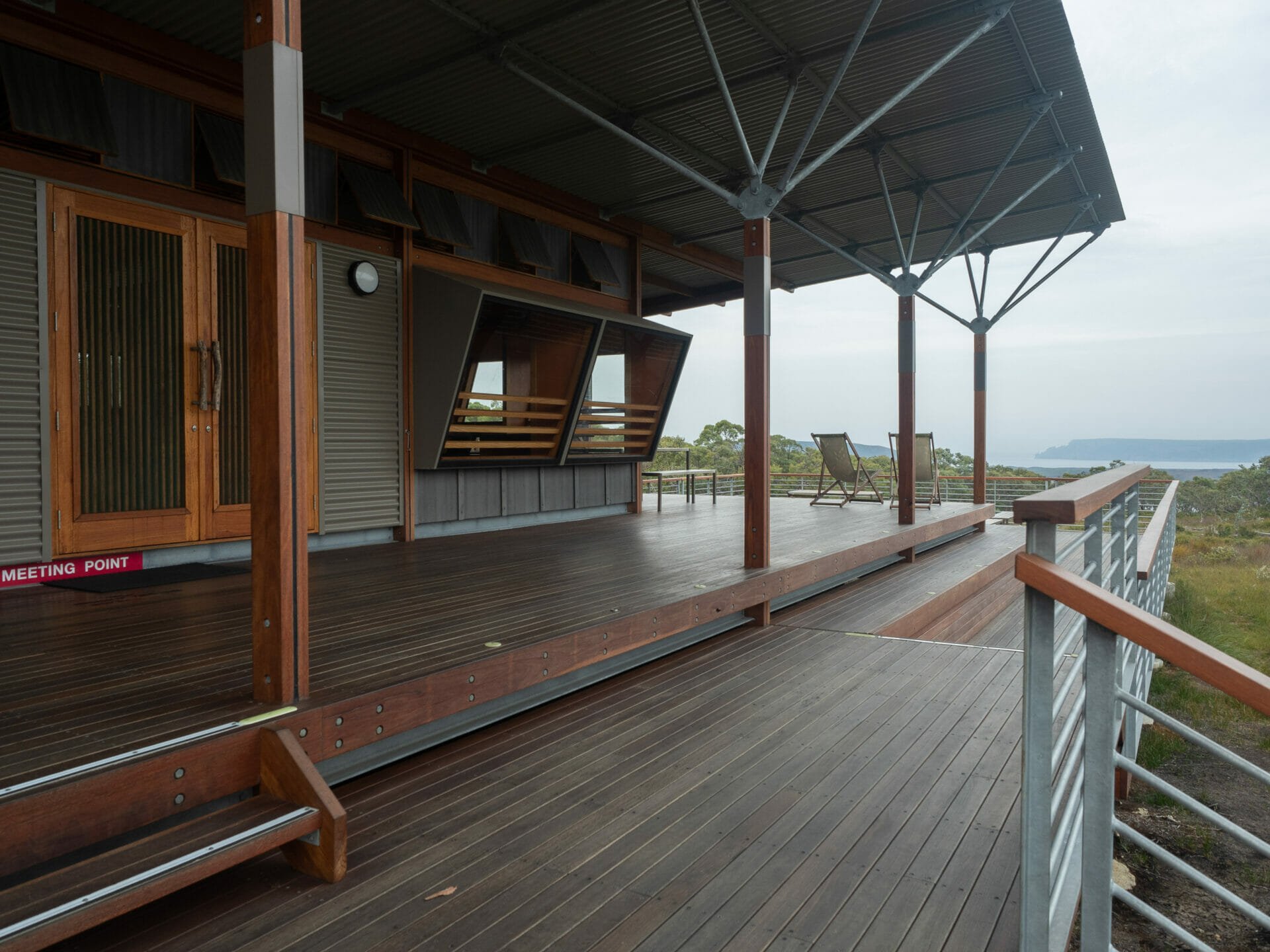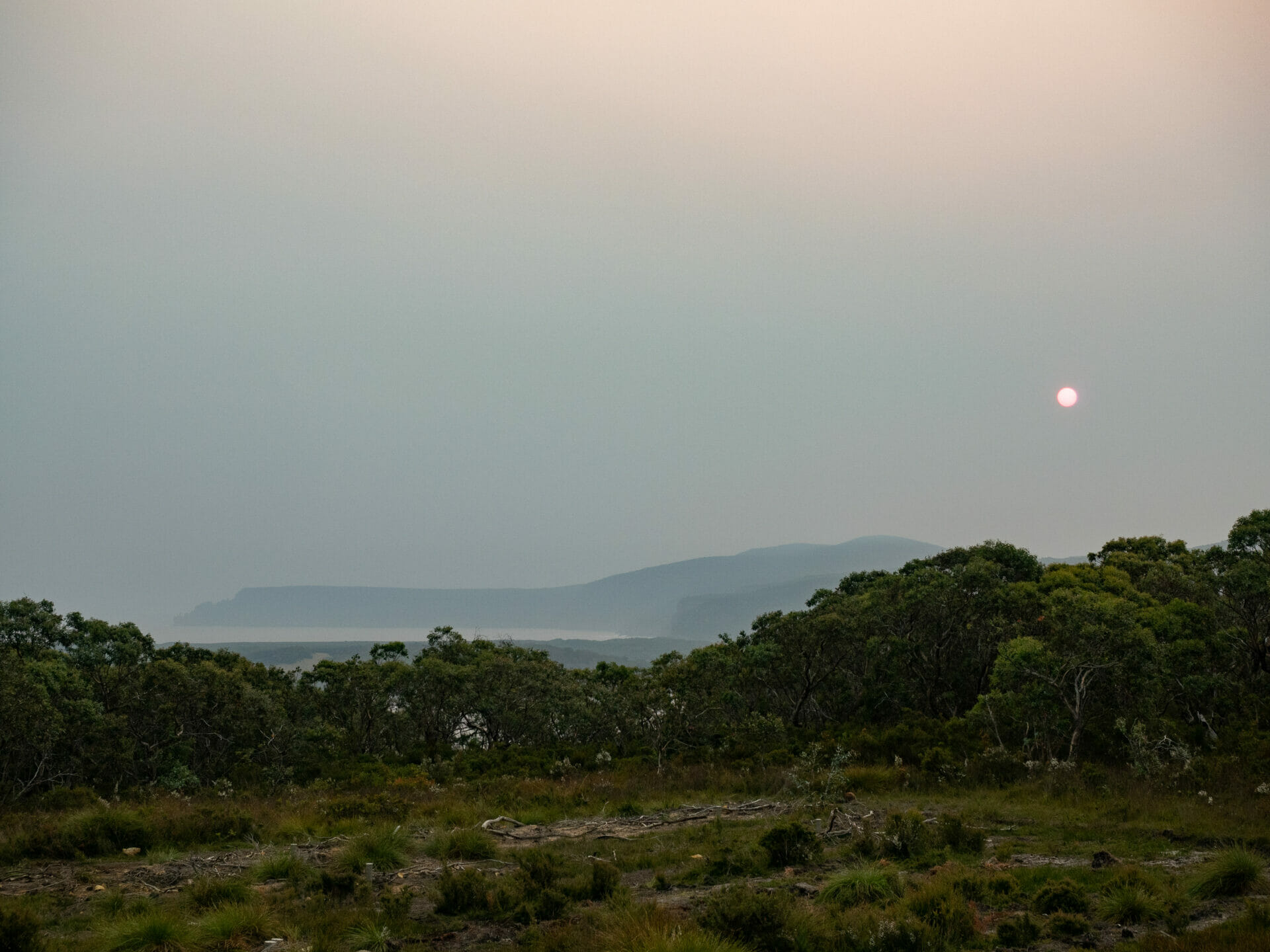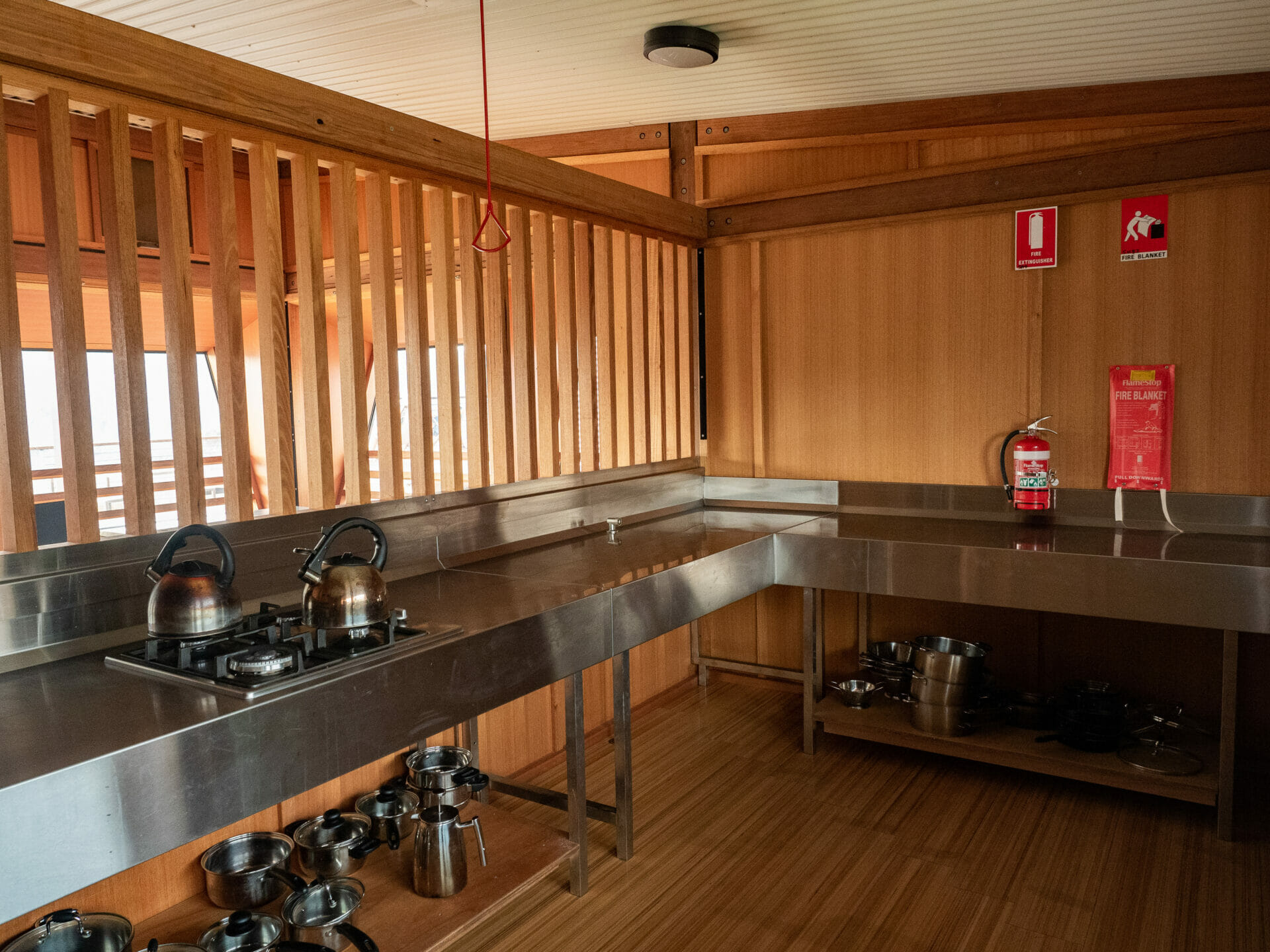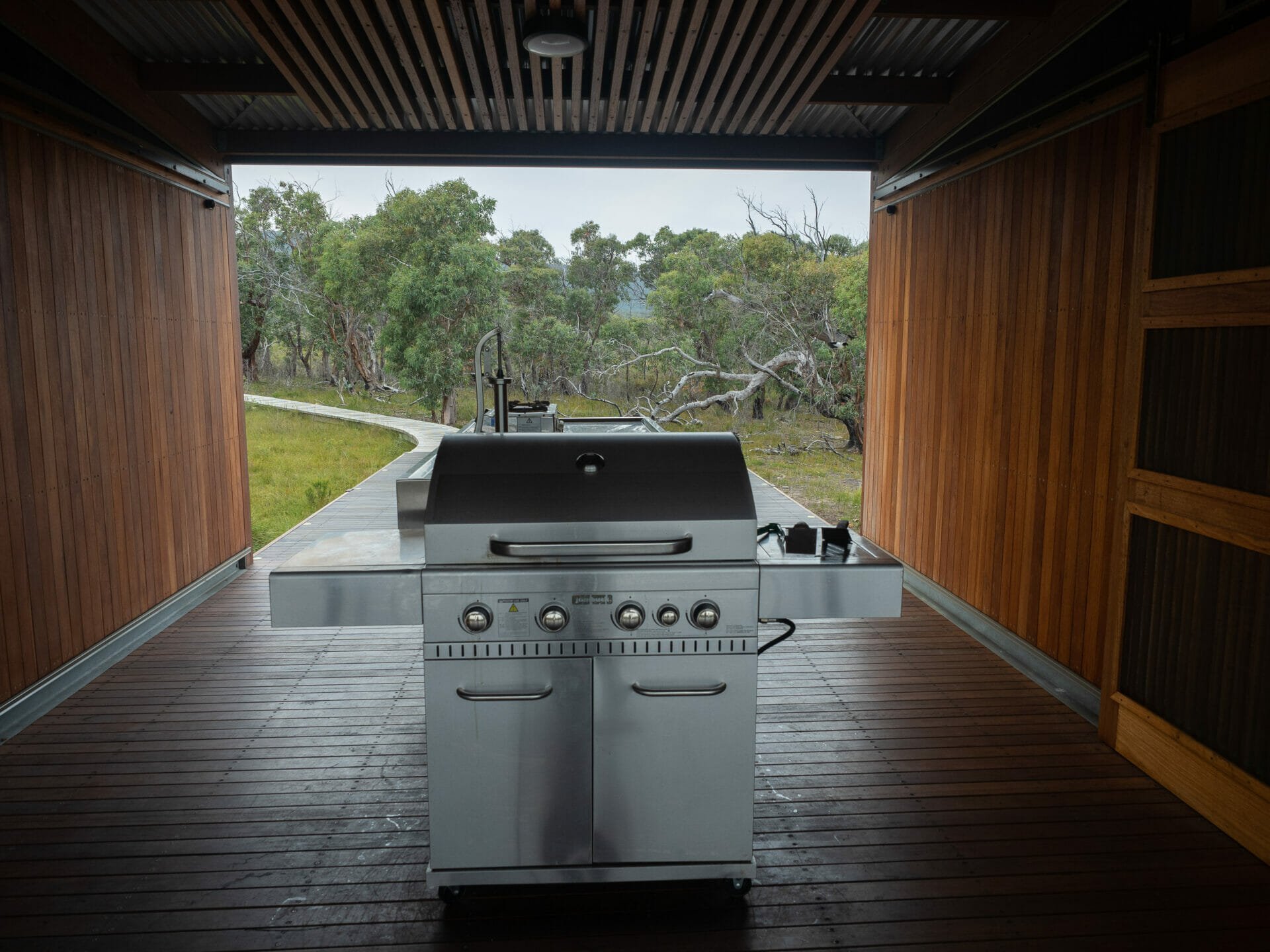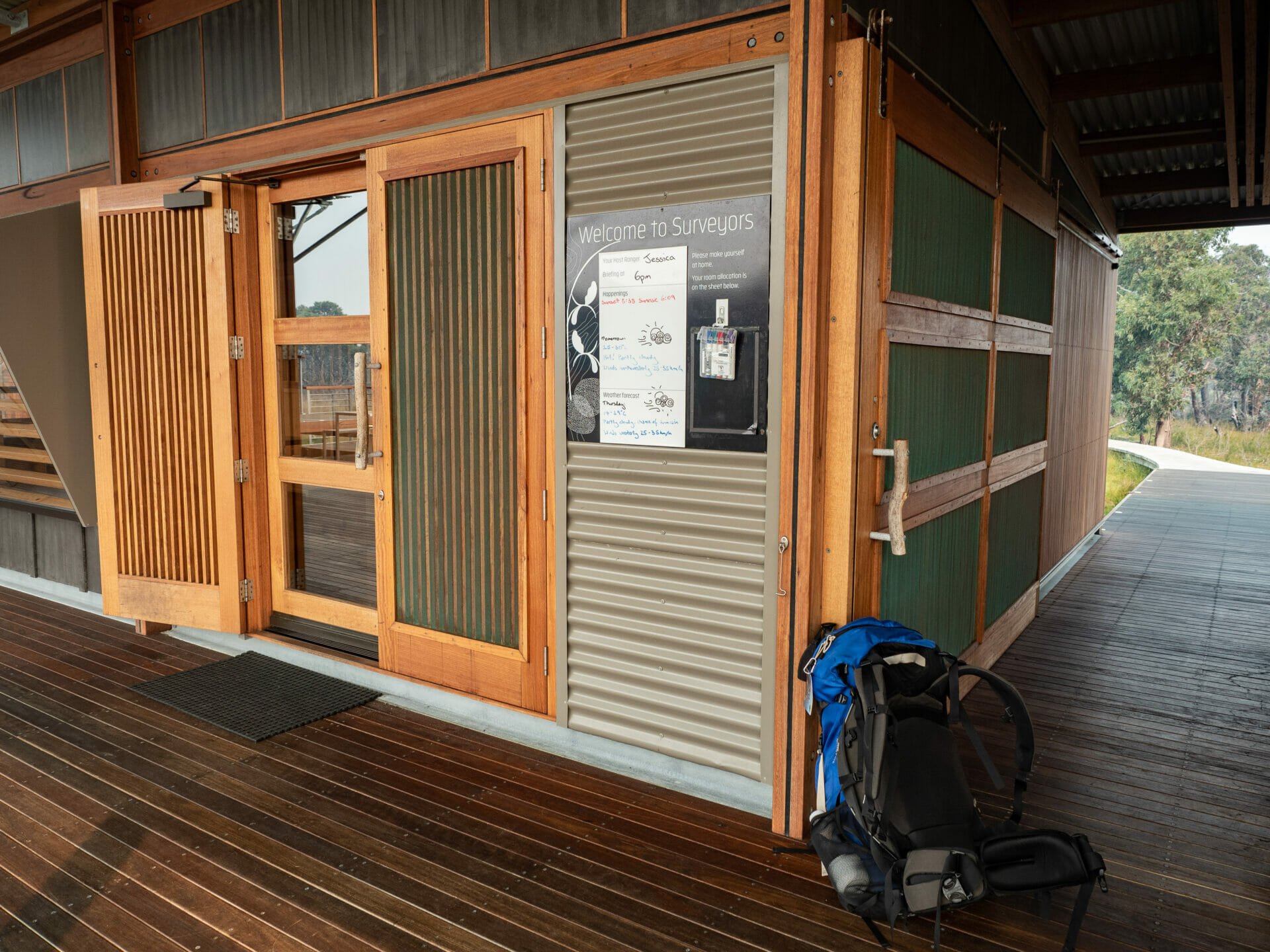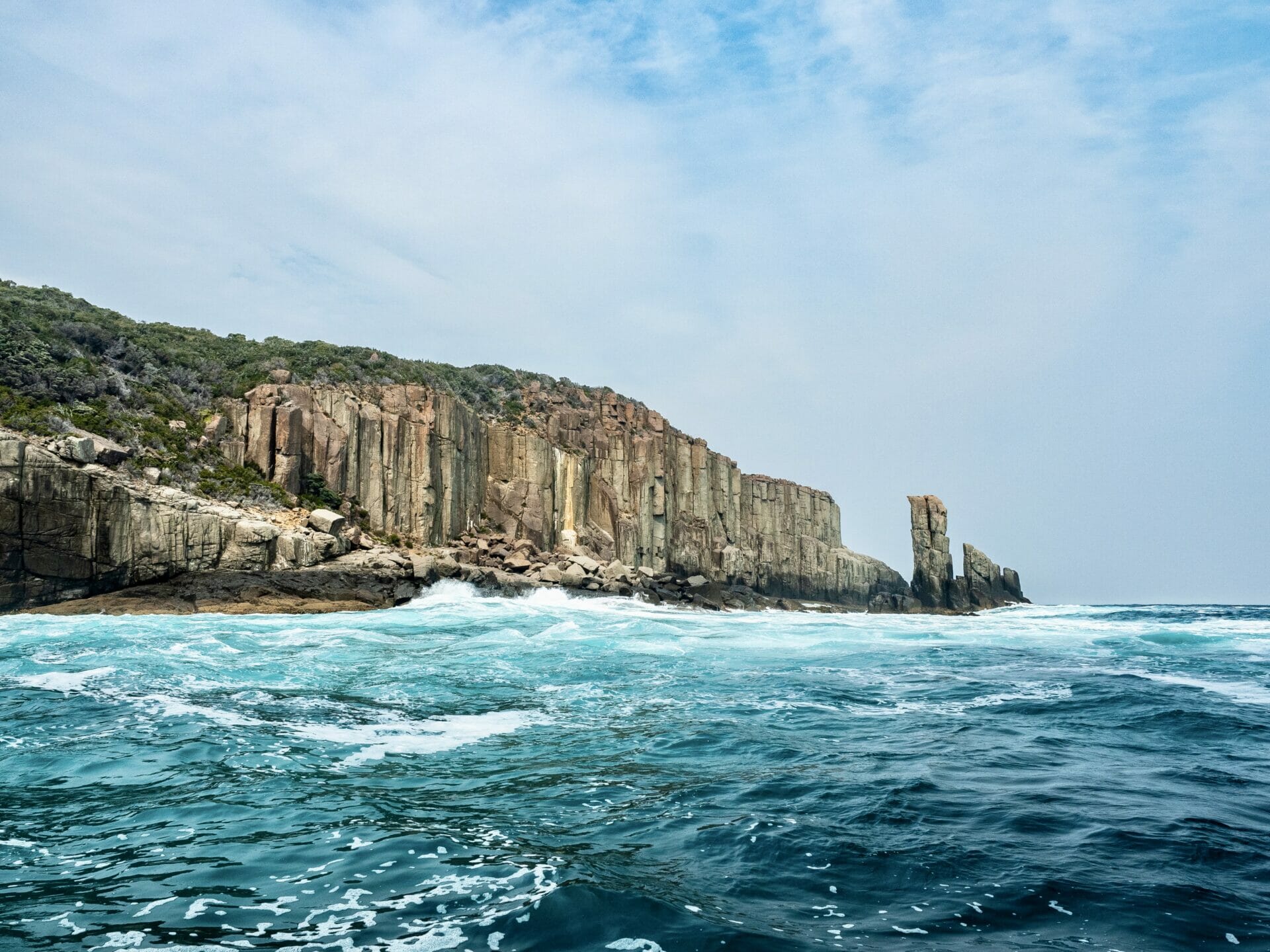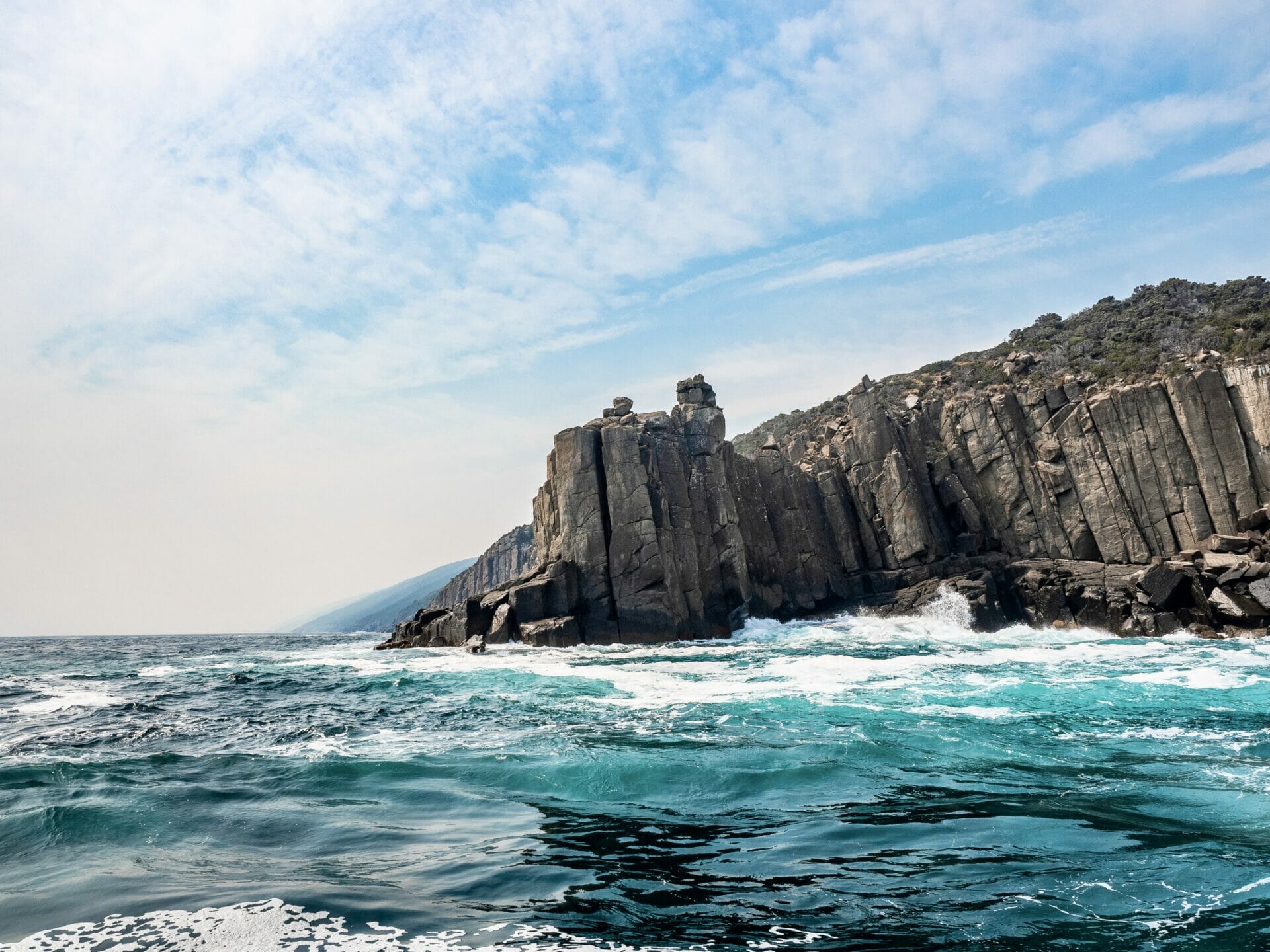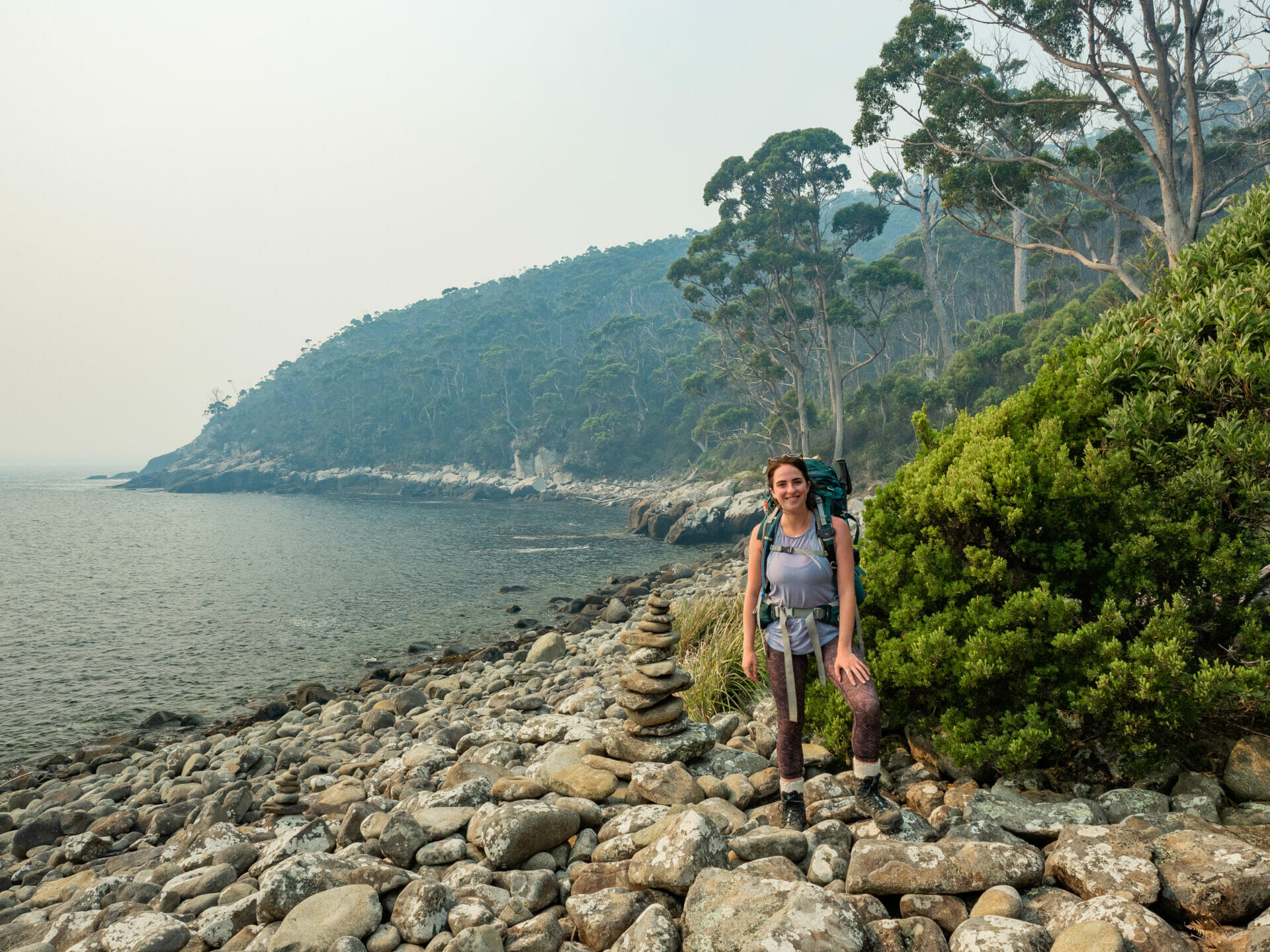
Three Capes Track (day 1): Denmans Cove to Surveyors
Last Updated on 9 February 2021
Our first day on Tasmania’s newest (and, dare I say, most breathtaking!) multi-day hike begins in the early afternoon with a scenic cruise along the capes and a short 4km walk to tonight’s accommodation. Still, these few hours manage to pack in more incredible scenery than I’d ever imagined, leaving us practically jittery as we anticipate the beauty that will surely follow over the next three days. This is going to be one for the books.
Trail stats: Denmans Cove to Surveyors
Distance: 4km
Trail hours: 1.25hrs, including 2 “storyseats”
Highlights: Scenic boat cruise from Port Arthur to Denmans Cove; incredible views of Cape Raoul from the boat and Surveyors Hut; smoky scenery at Surveyors Cove
Campsite: Surveyors Hut
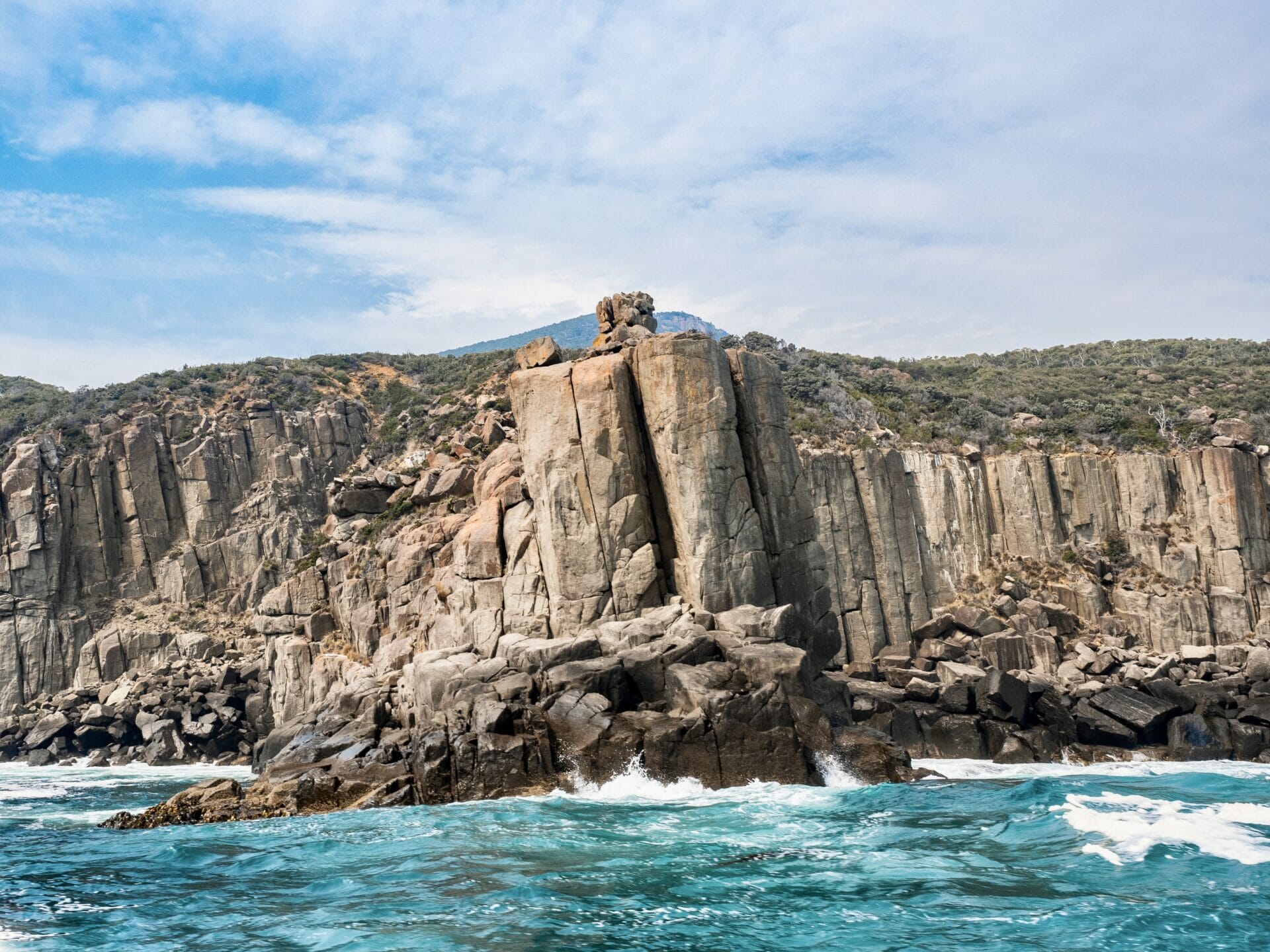
Exploring the Tasman Peninsula from the sea
- Our nice red uniforms
- Looking back on Port Arthur Historic Site from the boat
- Hopping onto the boat for our scenic cruise
- Our first glimpse of the sea cliffs
After checking in this afternoon at the Three Capes Track office on the lower level of Port Arthur Historic Site, dad, Eileen, Cal, and I set off for the jetty, where we are hustled onto a boat for our journey over to the start of the track. Rather than just a ferry, this is a 1.5hr scenic cruise, taking in heaps of the jagged dolerite coastline and surrounding beaches as we make our way towards Denmans Cove.
We all don bright red floor-length Gore-tex ponchos as we board to protect our hiking attire against the sea water, which is thrown over the entire boat several times during particularly violent swell, and the ride proves to be as adventurous as it is informative. Even with considerable forest fire smoke obscuring much of our view, the scenery is still unbelievable. By the time we do arrive onshore, we are all eager for the opportunity to experience this unique Tasmanian paradise up close!
- Beautiful sea cliffs
- Our pre-hike cruise
- The start of the track at Denmans Cove
Following some obligatory “Day 1” photos at the Three Capes Track sign, Cal and I hit the trail. Despite the short and relatively undemanding afternoon walk to Surveyors Hut, we are quickly sweating in the stifling heat, which has only been magnified by the thick smoke hanging in the air. Within the first 10 minutes, we reach a wooden bench overlooking a lovely stretch of coastline, the first of the walk’s many “storyseats”.
When we checked in for the Three Capes Track, we were given a Closer Encounters booklet that, in addition to maps and guides, contained several dozen stories, each designed to be read at a unique seat along the trail. Some of these stories focus on the convict history of the Tasman Peninsula, some on the geology of the area, some on the local flora and fauna, and others still on the development of the Three Capes Track. I honestly think these stories are an enormous part of what makes this hike so unique and interesting— it is truly an immersive experience rather than just a walk from Point A to Point B.
- Me and Cal at the start of the Three Capes Track
- The family
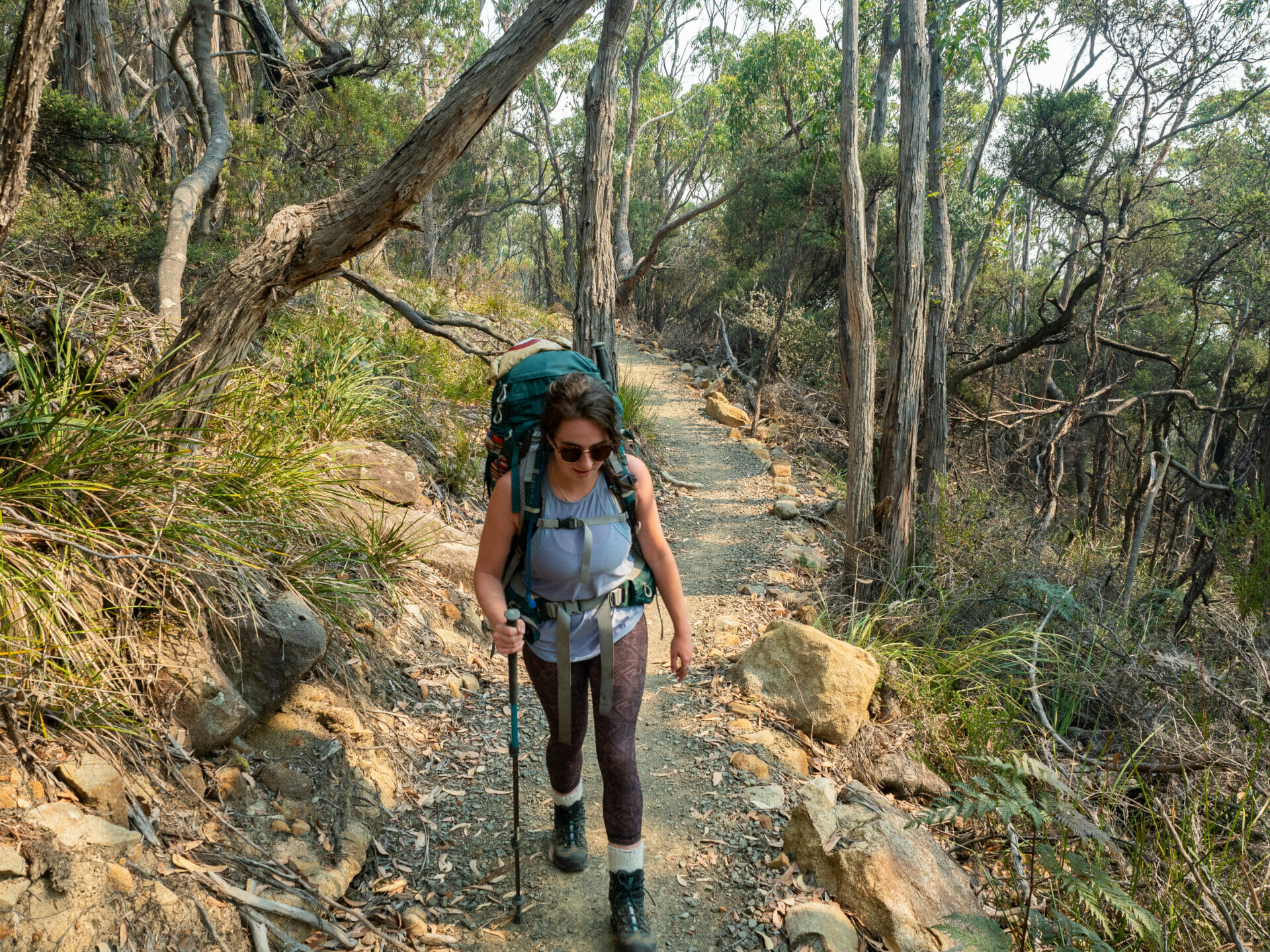
Smoky trail from Denmans Cove
Our first story contains a brief history of how some 12,000 convicts imprisoned at Port Arthur constructed the entire settlement over a period of 50 years, including their own prison buildings and a network of roads. This is contrasted by a story on the opposite page about the intensive construction of the Three Capes Track, which took a team of 100 labourers 5 years to complete. During this whole time, workers lived in camps alongside the track and were either flown in by helicopter or had to hike in at the start of every week. Whether forced labour or a “labour of love”, as the Closer Encounters book puts it, the storied past and continually advancing present of the Tasman Peninsula have made it a fast favourite for many visitors to the state, ourselves included.
Not long after our first storyseat, Cal and I find the second (and final) for today. Overlooking another beautiful stretch of coastline, we read about how one of the penitentiary’s commandants, Charles O’Hara Booth, implemented an ingenious form of long-distance communication at Port Arthur that decreased message relay time between the Peninsula and Hobart from 24hrs to 15min. The commandant sought out tall eucalyptus trees, usually over 25m, and affixed a series of paddles to the top, the precise angle of which could be controlled by ropes reaching all the way to the ground and which corresponded to letters or entire phrases— as many as 999,999 unique phrases could be achieved with just these three paddles.
As with most things at Port Arthur, convicts were responsible for the construction of these semaphores, and often even the operation, though it’s unlikely that they knew the exact content of the messages (which were often reporting escaped convicts to guards stationed elsewhere on the peninsula). At the time, this was an amazingly sophisticated method of communication that totally revolutionised life at Port Arthur; present day, Callum has full cell signal on the trail.
- On the way to Surveyors Hut
- Callum on a storyseat
- Our first storyseat of the trip

Beautiful smoky views
From this second story bench, we are about one-third of the way to tonight’s hut. Thankfully, the trail has been delightfully level, free of pretty much all roots and rocks, and lovingly graded (even I am finding it difficult to conduct my usual tripping and stumbling on this path). Around what I assume to be the halfway mark, we detour off the trail and onto a field of rocks that leads to a little beach. The smoke actually makes for some very interesting photos of the sea cliffs, but the desire to get out of the heat drives us onwards up a long series of stone steps.
- Callum on the trail
- Taking a quick breather at Surveyors Cove
- Smoky scenery on day 1 of the Three Capes Track
- Enjoying the tiny climb up to Surveyors
These steps seem to accomplish the majority of today’s 160m vertical climb, so even though we are slightly winded from racing to the top, we don’t have much more uphill to battle before the hut comes into view through the trees. Instantly, we realise how much larger Surveyors Hut is than any of those we saw on the Overland Track at the start of the month. 34 independent hikers depart each day on the Overland compared to 48 on the Three Capes, but still this hut appears to be two or three times the size of anything we’ve yet encountered in Tasmania, the only exception being the luxury Bay of Fires Lodge that we scored an afternoon invite to last week.
Actually, this hut is not terribly dissimilar to what we believed (at the time) to be the most beautiful lodge we’d ever seen. True, Surveyors doesn’t have the private rooms or pedicure stations that guests enjoy at Bay of Fires, but the modern, minimalist architecture definitely has a similar simplistic elegance and features the same elements (timber, steel, and glass). The structural highlight is the enormous decking that circles the entire hut, complete with lounge chairs and outdoor dinner seating, which really does capture the sense of being “inside when outside and outside when inside”, as the Bay of Fires Lodge described their own facility.
- Arriving at Surveyors Hut
- The incredible Surveyors Hut
- Smoky views from Surveyors Hut
- Amazing kitchen at Surveyors Hut
- BBQ at Surveyors Hut
- Checking in to Surveyors Hut
As we approach the hut, we are greeted by the energetic warden, Ranger Jess, who offers us a quick orientation tour of the facilities. She shows us the BBQs set up outside (some clever people have hiked in with frozen meat!) and the two indoors kitchens, both equipped with gas stove tops, cookwear, and a pump-action sink. Unlike a traditional hut, there are a series of bunk rooms, each containing either 4 or 8 beds, and between the rooms, a path runs out to the toilets. Also unlike anything I was expecting, the toilets are immaculately clean and a row of sinks offer clean water and biodegradable soap. It’s genuinely hard to believe that this is a publicly-operated hut!
When I express some of my amazement, Ranger Jess reminds me that the Three Cape Track was only completed in 2015 after 10 years of research, design, and construction, which makes these the newest huts in Tassie. Such a project was made possible by both state and federal grants amounting to $20mil, but it seems entirely realistic that the Parks & Wildlife Service will make the investment back considering the $450 price tag, substantially higher than other popular hikes in the state. As Jess says, though, people are willing to pay more when they can actually see their money being put into National Parks, as it has so clearly been here.
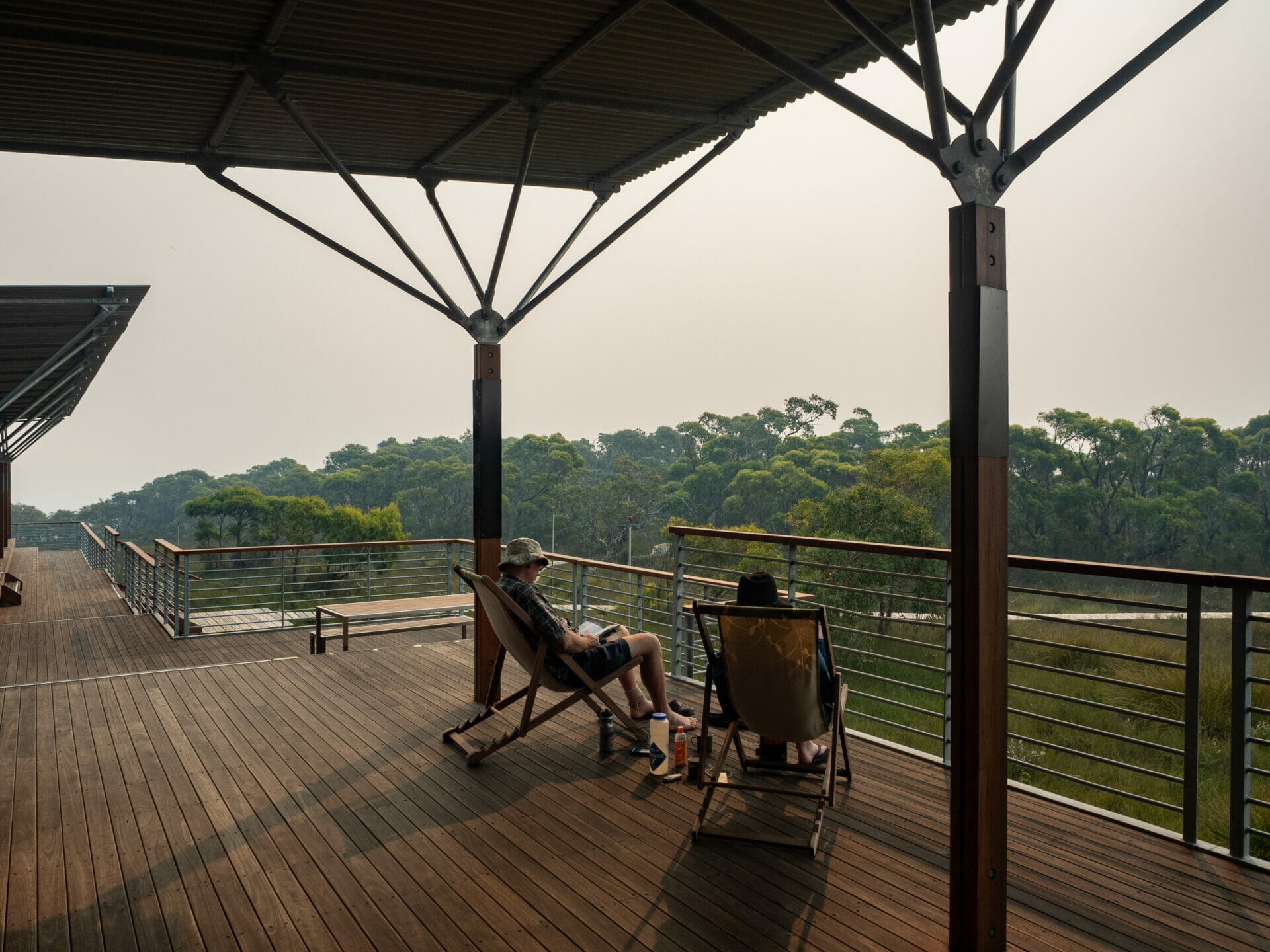
Enjoying a lazy evening at Surveyors Hut
After checking out our rooms and changing into some lounge clothes, we all head to an outdoor table and set to work mixing up our mountain margaritas. By the time we’ve polished off our first jug and an entire bowl of hummus, Ranger Jess has gathered everyone outside, conveniently right in front of our table, for a chat about tomorrow’s walk and to answer some FAQs. The question on everyone’s mind seems to be the ranger schedule, so she describes her rotating shifts for us: walking into Surveyors Hut with eight days of food, returning home for a 6-day weekend, and then repeating this three times until she transfers to the next hut for another rotation of three shifts. Her walk to today’s hut is the shortest and easiest of all the huts, so she says it usually means some better food while she’s here. Still, the rangers apparently carry 25-30kg when they are coming in for a shift, which is pretty remarkable considering that I’m probably only carrying about 12kg right now and my personal max was still just 15kg on the Overland.
In terms of other hikers along for the adventure, we learn through some casual surveying that the vast majority are Australian, which Jess says is also representative of the offical Three Capes statistics. Interestingly, about a third of the group has never been on an overnight bushwalk before and pretty much no one outside my family has been on more than a dozen overnight hikes.
I have a decent number of longer treks under my belt by now, but I can certainly see the appeal of starting here for a first ever hike. It would actually be challenging to find a more perfect introduction to overnight backpacking, given the incredible scenery and obvious comforts of the new huts— even Cal, who very openly dislikes hiking, is impressed almost to the point of enjoying himself. I actually catch him several times over the course of the evening looking a bit sparkly-eyed. Or maybe that’s just the margaritas..
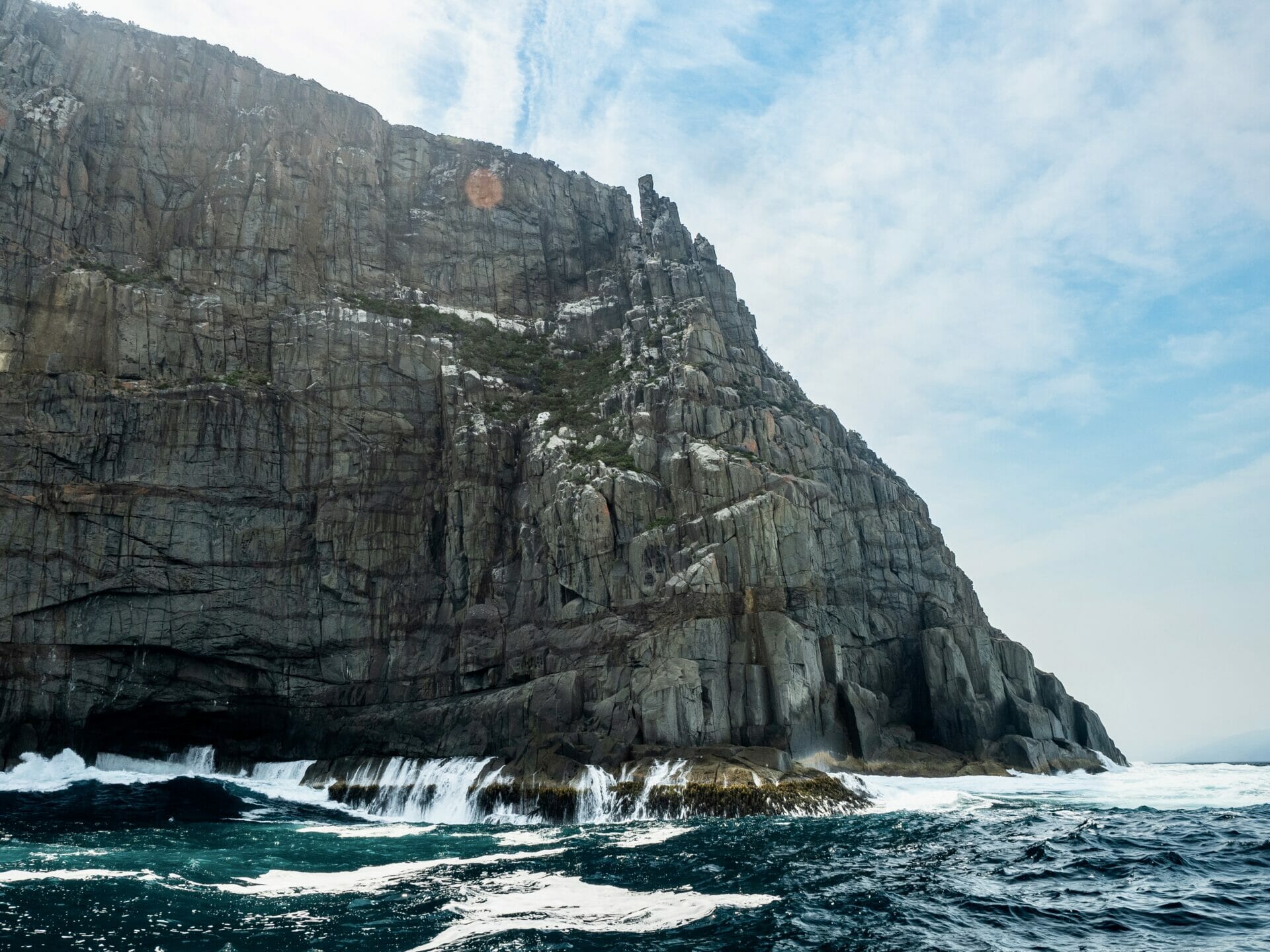
Our scenic pre-hike cruise
- Cape Raoul
- Exploring the Three Capes from the water
For those who are interested, Ranger Jess also shares the history of Tasman National Park and the Three Capes Track in greater detail. Previously a state forest, the area was designed a Park in 1999 for its substantial biodiversity and has seen about 600 walkers come through each year since that time. Following the inception of the Three Capes Track, however, where a little-known track was heavily revamped to provide better access for hikers (and limit damage to the surrounding environment), about 10,000 walkers now enjoy the trail each year.
It’s unclear what condition the route was before this revamp, but we do learn that it took more than 18,000 individual helicopter flights carrying 800kg of materials (each of which only translated to 3m of trail!), to construct the 35km of track we are now enjoying. The hut system in place here was also modelled after New Zealand’s, whose incredibly advanced network of walks we discovered a few years ago, so hopefully the success of the Three Capes Track will mean that more walks of this nature are created in Tasmania and throughout Australia. I’d absolutely get on board.
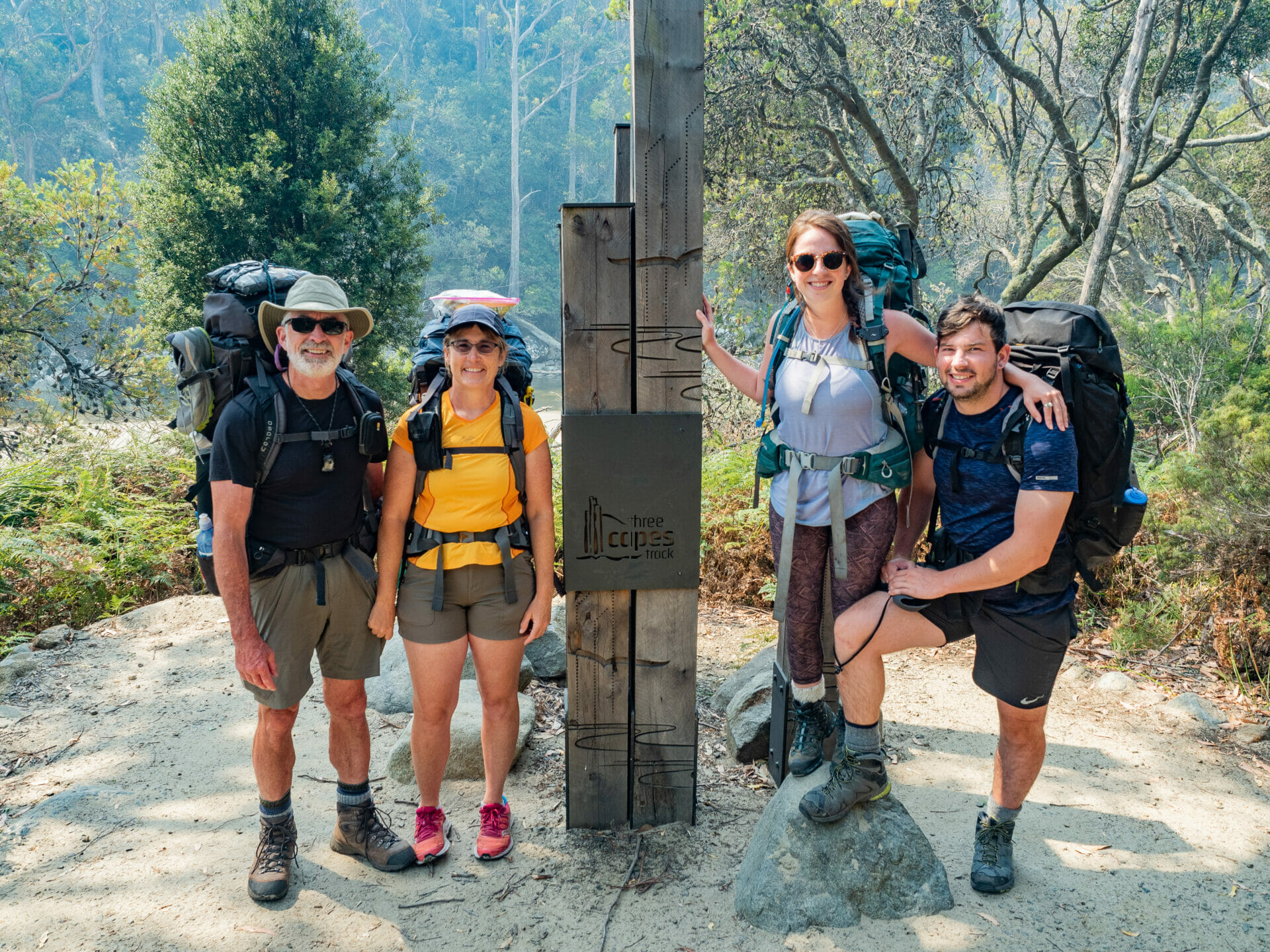
The family
Read more about our amazing Three Capes Track experience
THREE CAPES TRACK (DAY 2): SURVEYORS TO MUNRO VIA ARTHUR’S PEAK
THREE CAPES TRACK (DAY 3): MUNRO TO RETAKUNNA VIA CAPE PILLAR
THREE CAPES TRACK (DAY 4): RETAKUNNA TO FORTESCUE BAY VIA CAPE HUAY

